
WWW.NOURISHMAGAZINE.CO.NZ ISSUE NO. 54 AUTUMN 2024 BAY OF PLENTY, NZ ISSUE NO. 54 AUTUMN 2024 WWW.NOURISHMAGAZINE.CO.NZ FRESH LOCAL FLAVOUR BAY OF PLENTY, NZ PLUS CHOCOLATE, LAMINGTONS, MACARONS, OLIVE OIL AND SO MUCH MORE
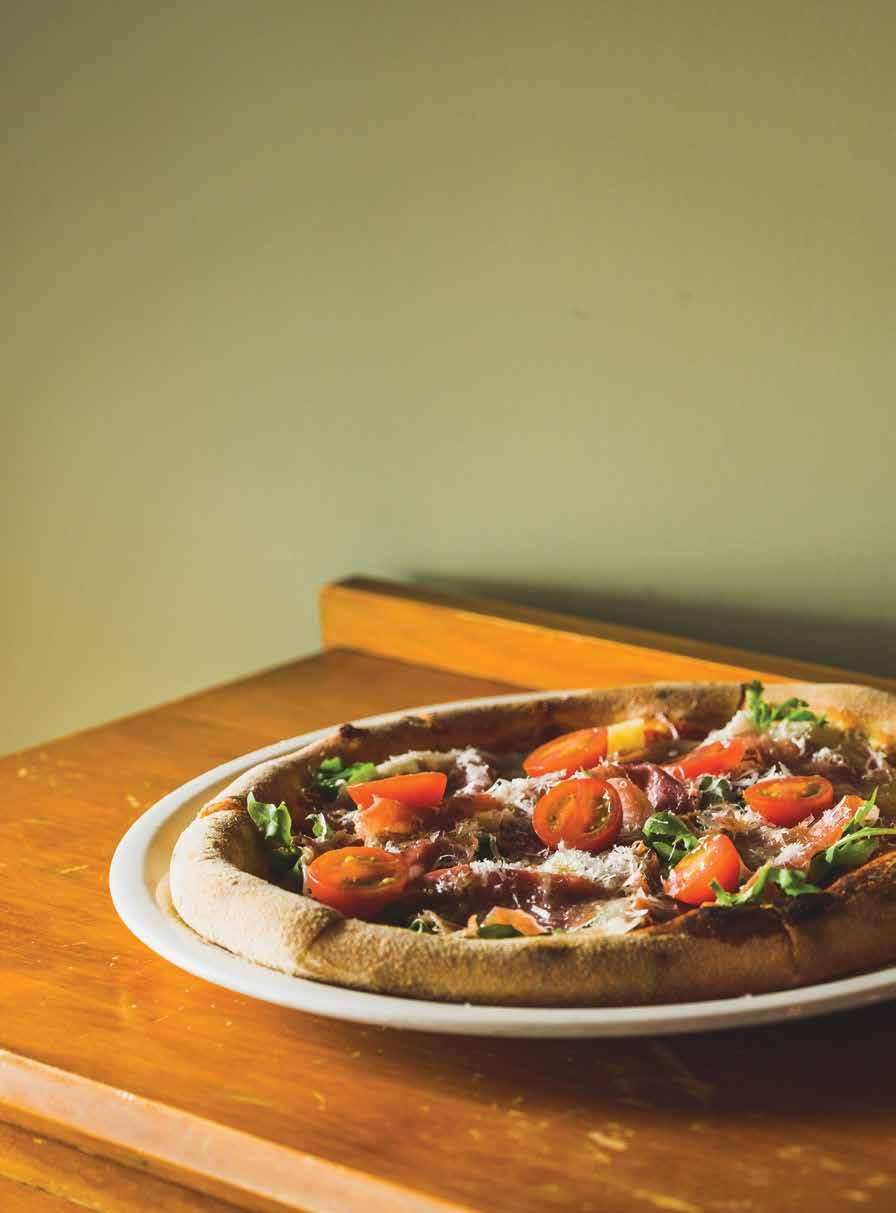

16 Pacific Ave, Mount Maunganui 43 Victoria Street, Cambridge www.alpino.co.nz
EDITOR Vicki Ravlich-Horan
HEAD DESIGNER Sara Cameron, Minted Design Co.
PROOF READER Nikki Crutchley (Crucial Corrections)
CONTRIBUTORS Denise Irvine, Emma Galloway, Amber Bremner, Liz French, Lynda Hallinan, Kathy Paterson, Harriet Boucher, Rachel Hart, Fiona Hugues, Vicki Ravlich-Horan, Megan Lyon.
COVER IMAGE Brydie Thompson
PHOTOGRAPHERS Brydie Thompson, Ashlee DeCaires, Emma Galloway, Amber Bremner, Kathy Paterson, Fiona Hugues, Vicki Ravlich-Horan.
ISSN 2324-4372 (Print) | ISSN 2324-4380 (Online)
ADVERTISING ENQUIRIES
Vicki Ravlich-Horan vicki@nourishmagazine.co.nz 0210651537

6 Vic’s Picks
7 News
22 Nutrition
34 Gardening
59 Beauty
66 Events
67 Marketplace
features
8 The Good Life – Part Two
12 Ask a Local – Whakatāne
16 Flavours of Plenty Festival
18 New Wave of Foodies
36 Gather Round the Dining Table
38 An Expansive Life on a Compact Site
44 Harriet’s How to – Lamingtons
60 Liquid Gold
regular recipes
10 A Good Curry
23 Unbeetable
26 Pack a Picnic
31 Oh, Onions!
41 Let’s Get it Macaron
46 Chocolate Lamingtons
48 Chocolate Recipes You Will Melt Over
53 Easter Pie
56 Pumpkin to Talk About
62 Olive Oil Recipes
38 Elizabeth Street, Tauranga CBD p: 07 571 0351 www.picnicka.com BAR & GRILL
7 Days Breakfast | Lunch | Dinner
Open
Here's to Autumn
Holy moly, how quickly did summer go? It’s late Feb as I write this, and I found myself wishing someone a happy new year yesterday!
I think I have lamented the speed of time passing before. It’s a pitfall of a job where we are always looking 1–2 seasons ahead.
The truth is the beautiful summer weather filled with afternoon swims, lazy lunches, regular happy hours and a string of long weekends has lulled me into a routine even school going back couldn’t break.
With this chilled out vibe I pondered whether 2024 should be the year of doing less. For those of you saying, “Yeah right”, you are right. While I loved a summer spent hanging, there are far too many exciting things coming up in the next few months, not to mention further into the year, for me to abstain. It is time to take the togs off and put my big girl panties on and get stuck into 2024 and all it will bring.
The Flavours of Plenty Festival is back in 2024 with a programme of over 40 exciting culinary events, check out page 16 for more details.
Easter comes early this year and sees me host our first Taste of South Australia tour which I am really looking forward to. This magical spot makes more than beautiful wine and we will be there to taste and experience it all while the autumnal colours put on a show.
With Easter in mind, Kathy Paterson bakes up a beautiful Easter Pie on page 53, while on page 48 Fiona Hugues will have you melting over her decadent chocolate recipes.
I have teamed up with Falls Retreat to put on a wonderful event in May. This includes a cooking demo from yours truly, a wonderful lunch and a copy of our Nourish Cookbook. We’ve timed it to make a great Mother’s Day gift but it's also a great way to spend a Sunday with friends.



Outside of Nourish I am a founding partner in The Feed. If you haven’t already signed up to our newsletter, do! (www.thefeed. co.nz.) At the end of 2023 my partner in The Feed, and New Zealand’s leading drinks writer, Tash McGill and I launched a podcast, The Sauce. You can listen in on Spotify or Appleplay. And while it is weird listening to yourself (say “you know” 200 times in 30 minutes), I am excited about what we are building and the conversations we can have with those doing innovative and awesome things in the New Zealand food and beverage scene.
Tash and I also chat about what we’ve been eating, so with that in mind let’s look at what you could be eating this autumn with inspiration from some of our talented recipe writers.
Keeping with the chocolate/Easter theme, Harriet tackles making the perfect lamington on page 44. Emma Galloway digs up her crop of beetroot for some unbeetable recipes on page 23, while Amber gives us pumpkin to talk about on page 56. On page 31 I run rings around onions, frying them in several delicious ways. And on page 10 Wayne Good shares with us a curry recipe made with homemade paneer.
On page 60 I get the pip with confusing and misleading olive oil labels before creating some beautiful confit garlic you will love having in your fridge.
If you are wanting to extend the summer vibes a little longer, check out our locals’ guide to Whakatāne on page 12 and read about the new wave of foodies in Whangamatā on page 18.
Enjoy!
 Vicki Ravlich-Horan Editor
Vicki Ravlich-Horan Editor




NOURISH | ISSUE 54
FOLLOW US ON SOCIAL! facebook-square instagram @nourishmagazine PAGE 5 | WWW.NOURISHMAGAZINE.CO.NZ
NED COLLECTIONS CERAMICS
Chalk & Charcoal have added to their beautiful range of home and giftware a selection of gorgeous NED Collections ceramics. With their organic form and natural palette these are pieces you just want to pick up and touch. The pieces include mugs, platters, little condiment dishes, serving bowls and vases, each appearing to be very delicate but in fact made from durable stoneware which is dishwasher and microwave safe.
Owner of Chalk & Charcoal, Sharon tells me the range of beautiful little vases make the perfect gift!
Chalk & Charcoal
Te Puna Shopping Centre, 4 Te Puna Road, Te Puna
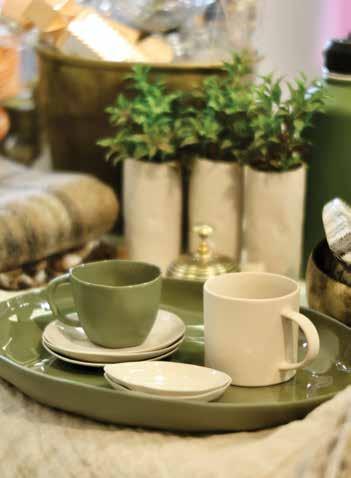

Vic's Picks 1. 3.

SIGN UP FOR THE 100K’S IN 30 DAYS CHALLENGE
Get fit, have fun and do something good for your fellow Kiwi living with a breast cancer diagnosis – sign up for the 100k’s in 30 Days Aotearoa challenge, taking place 1–30 May and helping raise essential funds for Breast Cancer Support Services Tauranga Trust (BCSST).
You can complete the 100km distance however you wish across the 30 days of May – be it on foot, on wheels, on water; in big chunks or small; on your own, or as part of a team. Why not rally your work mates and sign up as a business team?
BCSST Manager Rachel Quin Gilbert says, “The 100k’s in 30 days challenge is our biggest fundraiser of the year and a massive event for our charity. We love seeing the enthusiasm that comes out in participants and really hope our local community gets behind the 2024 challenge. We would love to smash our fundraising target this year!”
Event registration is open from 27 March at www.100ksin30days.nz.
THE SAUCE PODCAST
Join myself and partner in crime from www.thefeed.co.nz Tash McGill on our new podcast The Sauce. Listen in as I moan about Tiktok trends, and we discuss what we are loving/ eating/drinking at the moment along with interviews with those in the New Zealand food world, from top chefs to innovators in their field.
Who wouldn’t want me in their ear!
Listen on Spotify or for more details go to www.thefeed.co.nz
PAGE 6 | WWW.NOURISHMAGAZINE.CO.NZ
OPEN IN MOUNT MAUNGANUI
Clover Design Store and Deli opened just before Christmas in downtown Mount Maunganui. Here you can find timeless homeware and design pieces to complement your space and style.
Step inside to discover beautifully crafted design pieces, including designer furniture by Sika Design and Kristina Dam Studio, to exquisite homeware by Waiheke Ceramics and Cultiver linen. Each item is handpicked to transcend passing trends and to be cherished for generations to come. Enormous effort has been placed into filling the store, with each piece showcasing the finest in artisanal craftsmanship as well as being ethically sourced.
This ethos extends to the deli and pantry section, where you will find a gorgeous range of French cheeses, as well as locally baked fresh bread and pastries, beautiful spreads, cured meats, and seasonings. Pop in store for a coffee and linger a little longer as you peruse the gorgeous range on offer.
Clover Design Store, 159 Maunganui Road, open 7 days a week.


LUNCH WITH NOURISH
We’ve teamed up again with Falls Retreat for another great Sunday lunch event. Our last two in 2023 sold out. Join me at Falls Retreat on Sunday 26 of May where I will be demoing a few great recipes from our cookbook which you will get a copy of to take home. We’ll then sit down to a wonderful lunch cooked by Brad and the team at Falls Retreat. This would be a great Mother’s Day gift or simply a great excuse for a day out with friends.
Tickets via www.fallsretreat.co.nz



NOURISH TASTE OF TOURS
We have just four spots left in our 2024 Taste of Sicily Tour, so if you are keen to join Vicki for 10 amazing days discovering this special island’s history, culture and food don’t delay!
If you can’t make it to Sicily this October but are eager to get a taste of the world, you might want to get your passport up to date, as we have more tours in the works for 2025, including Sri Lanka, Sicily and South Australia.
If you want to be the first to know about these trips please email vicki@nourishmagazine.co.nz
News
PAGE 7 | WWW.NOURISHMAGAZINE.CO.NZ

WORDS DENISE IRVINE | IMAGES ASHLEE DECAIRES PAGE 8 | WWW.NOURISHMAGAZINE.CO.NZ
(part II)
Wayne Good has made plum cake for afternoon tea, a soft fruity beauty using his own Luisa plums and eggs from his chooks. It is the taste of summer, served with thick, decadent clotted cream.
Wayne makes the clotted cream with milk from cows on the farm near his home, and he gives a quick rundown on the method: “Heat a saucepan of milk to 80 degrees Celsius, switch it off, place a round of baking paper over the milk (but not the lid), leave it to cool on the stove, refrigerate overnight, in the morning peel off the paper and a thick layer of clotted cream will be stuck to it.”
It’s perfect with the cake, and Wayne also uses it in sauces, scrambled eggs and quiche.
Pretty much everything he eats – eggs, fruit, vegetables, herbs and condiments – comes from the 1ha property at Gordonton, near Hamilton, where he has lived for nearly three and a half years. “I also make my own bread but I just can’t eat the animals from around here. I have to buy meat elsewhere.”
Wayne is a trained chef, his business is Arkanda Living & Antiques, and under its broad umbrella he runs an annual series of sell-out culinary demos in his kitchen; leads small group tours to France, Spain and Portugal; and has an antiques barn adjacent to his home, stacked with collectables – furniture, fine china, art, mirrors, crystal, and other furnishings – sourced at estate sales, auctions and similar. He is committed to the notion of sustainable living, of avoiding waste, and recycling and repurposing.
Wayne has previously offered an Arkanda interior design service, but he’s recently sidelined that after 28 years and has filled the gap by catering for private dinner parties. And for something entirely different, he has a regular afternoon gig in the cowshed on the farm where the milk for the clotted cream comes from. “I do what makes me happy.”
So welcome to The Good Life, Part II: Nourish is revisiting Wayne after an earlier story (Nourish, Summer 2020) when he relocated a tiny cottage to Gordonton, opened the antiques barn and moved from town to country.
Back then he would never have dreamed of being in a cowshed each day, spending untold hours on a ride-on mower taming his large lawn, owning 21 Indian runner ducks, harbouring a broody hen under his tomato plants, having three goats over the back fence (Betty, Bertie and Gertie), and being woken each morning by George the resident rooster.
To recap briefly, Wayne’s home is a 1940s weatherboard cottage, originally from the old RNZAF Station Hobsonville, near Auckland. He found the cottage in a house-mover’s yard. It was a wreck, it cost him $1, and it was trucked to its present site just before New Zealand’s first nationwide Coronavirus lockdown in March 2020. It has since been refurbished, judiciously extended and is now 80sqm and filled with his favourite collectables. Every inch of usable space is occupied by something beautiful.
“Things cycle in and out of the barn and home. I’ll buy something for the antiques barn and then move it across to the house. But I have a strict policy of one in, one out.”
In his small kitchen, Wayne’s gone for the French tradition of using cabinets, dressers and curtained cupboards for storage rather than the typical fitted New Zealand kitchen. He’s recently added a 17th century English gentleman’s chest to the cabinetry and it now holds cutlery and other items.
Wayne hosts his culinary demos here and last year there were 400 enrolments for his Christmas classes. Other demos cover French and South East Asian cuisines, high tea, and New Zealand and

European favourites. This year he’s adding a class on northern Indian cuisine, known for its biryani, palak paneer, saag, samosas, pakora, and use of aromatic spices.
He’s recently had the pleasure of learning to make pakora (spicy vegetable fritters) with a friend of Indian heritage. “There was no recipe, we cooked together and I took pages of notes. Now I make the best pakora, and a really good dahl, and paneer and potato curry." (See recipe, next page.) The new food focus ties in neatly with Wayne’s plans to take a tour group to India next year.
Wayne is similarly enjoying the dinner parties he caters for in private homes: there is a minimum of eight people, maximum of 20, and for the bigger events he has Hamilton chef Ashleigh Brodie to work with him.
Menu options are discussed with the hosts, and the $125 per head cost covers a platter for pre-dinner drinks, and a three-course meal. “We cook, serve, clean up and disappear. I don’t do picture-perfect plates; it is beautiful, wholesome, seasonal food and everything is made from scratch.”
He’s just signed off a dinner menu starting with prawns served with green leaves, coconut shards and Vietnamese dressing; whole eye fillet with truffle and red wine jus; and lemon posset with tuile biscuits and fresh raspberries. “There will be a salad with lots of fresh herbs because this client loves herbs.”
We finish our plum cake and cream, head outside to meet the menagerie of chooks, ducks, goats, pigs and cows, admire the abundant garden, and I’m coveting a few pieces in the antiques barn.
“I love my life,” says Wayne, as he seamlessly points out the broody hen under the tomatoes and a stunning collection of English Mason’s Regency china in the barn. “I feel grateful every day that I’m here, doing what I want to do.”
You could say it’s a good life!
Arkanda, 128A Whitikahu Road, Gordonton arkanda.co.nz
NOURISH | FEATURE PAGE 9 | WWW.NOURISHMAGAZINE.CO.NZ
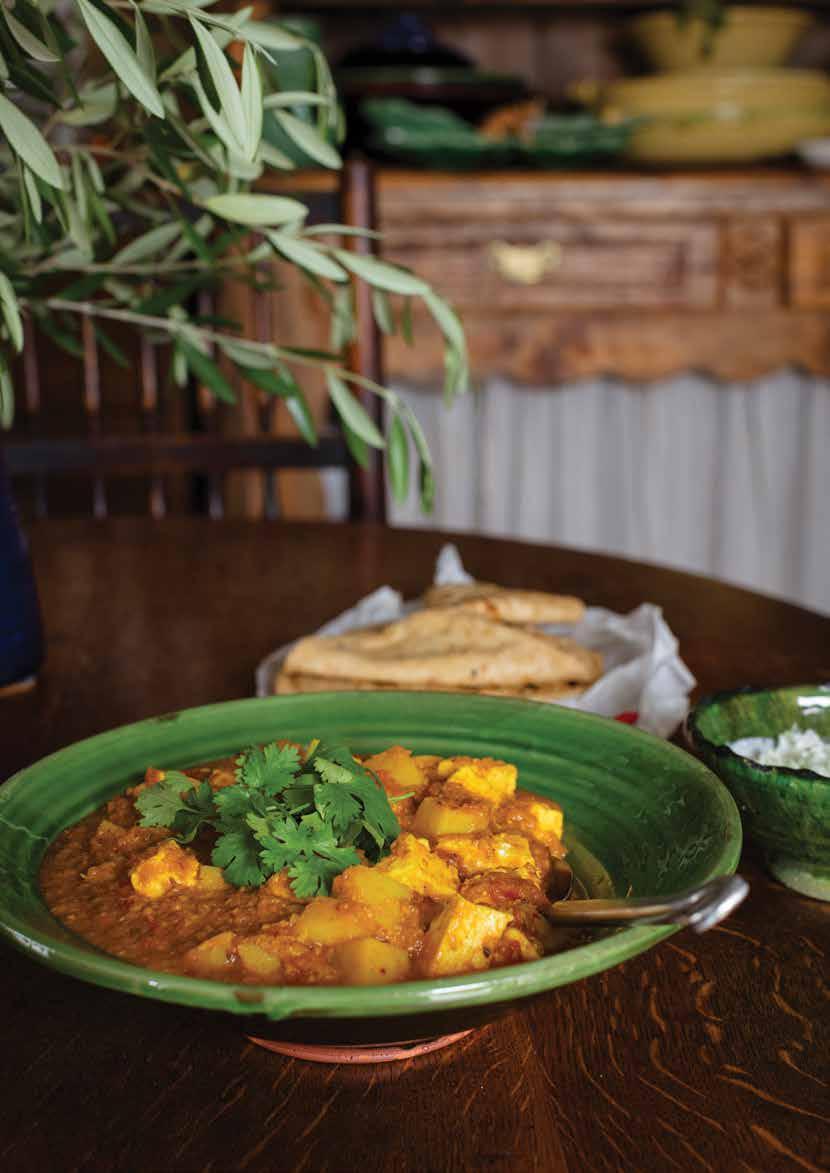
Good CURRY
Living and working on a dairy farm, I enjoy the challenge of living as self-sufficiently as possible. Having access to beautiful fresh milk allows me to make my own butter, mascarpone, yoghurt and this beautiful paneer, which is one of the recipes I have had the very good fortune of being shown how to cook from the north of India.
RECIPES WAYNE GOOD | IMAGE ASHLEE DECAIRES
PAGE 10 | WWW.NOURISHMAGAZINE.CO.NZ
PANEER
I use full fat milk from the farm for this, but store bought will work just as well. Just ensure it is full fat (silver top is best).
4 litres of full fat milk
½ cup white vinegar
In a large pan bring the milk to just under the boil. Add the vinegar and stir. The milk will automatically form curds and whey.
Place a large piece of cheese cloth (available from Simply Divine Kitchen in Cambridge) into a colander, completely lining it. Strain the curds and whey through the cheese cloth.
Bundle the curds up in the cheese cloth and press with a very heavy weight (a cast iron pot filled with water works well). Leave for 24 hours at room temperature with the weight on top.
Once this has happened, the cheese is ready to use. It can be stored in the fridge for 3 to 4 days.
PANEER AND POTATO CURRY
3 tbsp ghee
2 tsp cumin seeds
2 large onions
1 whole garlic bulb
1 large piece of ginger
2 tsp salt
1 tsp turmeric
2 tsp garam masala
½ tsp minced chilli
1 400g tin diced tomatoes
700g cubed waxy potatoes
500g cubed paneer
fresh coriander, chopped, to serve
Melt the ghee in a large pan. Add the cumin seeds and lightly toast. In a food processor, process the onions, garlic and ginger quite finely. Add to the ghee and cumin and cook gently for 10 minutes. Do not allow to burn.
Add the remaining spices and salt. Cook for a further 2 to 3 minutes. Again, make sure the pan is not too hot as you do not want to burn the spices.
Add the tinned tomatoes and 2 cups of water.
Finally add the potatoes and simmer, covered, until the potato is tender.
Check the seasoning.
At the end, add the cubed paneer and gently warm through. This curry can be made in advance and stored in the fridge. To change it up, add green prawns when adding the paneer – delicious!
Serve sprinkled with chopped fresh coriander, roti and raita.
ROTI
4 cups chapati flour + extra for rolling
oil for greasing bowl warm water butter
Place the flour into a large bowl and add enough warm water to form a dough, the consistency of a bread dough. Knead in the bowl for a few minutes.
Oil another bowl and place the dough into the oiled bowl and rest for 10 minutes.
Heat a roti pan on your stove.
Take a small handful of dough, about the size of a small bun. Using your fingers, start creating a round shape, before placing onto a floured surface. With a rolling pin, roll into a very thin disk.
Set a roti rack over a gas flame, with the flame on medium.
Place the roti onto the pan, and cook until the colour changes, then turn. This will only take a minute or so.
Remove the roti from the roti pan and place on the rack over the gas flame. The roti will puff up. Turn over, and using a fish slice, push the steam out of the roti.
Remove and place into baking paper lined tinfoil. Brush each roti with butter.
Continue until all the dough is made. Keep warm and serve with the curry.
A roti pan is a very flat pan, similar to a crêpe pan. A good cast iron pan or the flat part of your BBQ are good alternatives.
EXPERIENCE THE FALLS RETREAT
BOOKINGS 07 863 8770
www.fallsretreat.co.nz
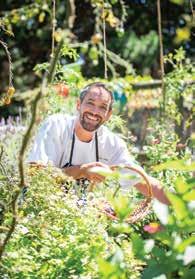


experiences, accommodation, cooking & gardening workshops
info@fallsretreat.co.nz Dining
NOURISH | RECIPES
PAGE 11 | WWW.NOURISHMAGAZINE.CO.NZ
Ask a Local WHAKATĀNE

If you’re looking for the true taste of a town you need to talk to the locals. Where do they get their coffee? Where do they love to eat out?
So we asked a few Whakatāne locals to give us the inside scoop on this piece of paradise in the Eastern Bay of Plenty.
PAGE 12 | WWW.NOURISHMAGAZINE.CO.NZ
WORDS VICKI RAVLICH-HORAN

BRING ON BRUNCH
Oliver Dobbin from Salt Spray Surf School says his go-to brunch has to be Cafe Awa. Noting it’s a great spot with great food and people, Oliver says, “Being able to stroll along the riverside after a filling brunch is a favourite Sunday activity of mine.”
Maria Grant, Community Engagement Advisor at Whakatāne District Council and owner of A:M Clothes agrees: “My go-to spot is Cafe Awa. It has yummy coffee and kai; the staff are always very friendly. It’s a lovely light space with lots of sunshine. Plus being able to sit outside and see the awa is always good for the wairua/ soul!”
If location is what you are after, Glenn Smith from One Double X says you can’t beat Fisherman’s Wharf. Glenn says, “Fisherman’s Wharf has a beautiful outlook, yummy food such as the smoked fishcakes and excellent Bloody Marys.”
Colin Stobbie from The Good Tonic Design studio and store is a fan of the Smoking Goose, which is a 10-minute drive inland from Whakatāne. Mouthwatering barbecue meats infused with a Kiwi twist are on the menu. Colin says it’s a great place to catch up with friends, with too many great options on the menu to choose from. Whakatāne Mayor Dr Victor Luca notes Moxi’s in Ōhope is always busy so has to be on the list.
CAFFEINE FIX
Moxi Cafe in Ōhope is not only popular for brunch, they do a great brew according to Maria. And she says they get “bonus points for being close to a papa tākaro/playground so you can get your caffeine fix takeaway and the kids get to burn their energy and have fun too!”
Megan Taylor, owner of Moxi’s, would agree with Maria but admits on her day off when she is in need of a caffeine hit, she’ll head to

Oliver says Dream Bean Coffee at West End, Ōhope Beach is his go to. “This is a no brainer!” says Oliver. “The coffee is as good as it gets and their cute coffee cart is parked right at my favourite part of Whakatāne/ Ōhope, West End Beach.”
Natasha Manuel from Tio Ohiwa Oysters agrees with Oliver, not just on the coffee from Dream Bean but that they are parked at the best beach in New Zealand.
In town Volk & Co Coffee Brew Bar on Boon Street came up again and again, with the mayor noting its popularity among council staffers.
Jord Espresso based at The Hub.
NOURISH | FEATURE PAGE 13 | WWW.NOURISHMAGAZINE.CO.NZ

BEERSIES
If you’re after a beer in Whakatāne a local brew from Mata is a must says Megan. Oliver adds that over the summer months the Mata team set up at Wharfside at Port Ōhope Wharf. “This is still a bit of a secret spot and the best place for an arvo beverage. Sipping on locally brewed beer or cider and looking out over the harbour for sunset – unreal!” comments Oliver
Maria says her “favourite spot over summer has been the General Store Ōhope – again, bonus points for having wine and beer for the adults, and ice-creams for the kids! Those million-dollar views are a pretty sweet extra too.”
For Glen it’s upstairs at the Whakatāne Sportfishing Club where he says you will find great river views and friendly staff. And for Colin it’s The Comm for great beer and a menu that is spot on.
Mayor Luca says, “The Comm has had many ‘lives’ since 1894 – it was certainly a pretty lively public house when I was growing up in Whakatāne. It’s been refurbished into a gastropub and accommodation in recent times and has fast become ‘the local’ for many.”
DINING OUT
Glenn loves The Comm for a great dinner out while for Oliver his go to is Cadera Mexican Bar and Restaurant in Ōhope where he says, “the fish tacos are incredible!”
Maria loves Double Zero, saying “their pasta and pizza flash me back to my days of travelling around Italy!”
While Megan from Moxi Cafe agrees with both Oliver and Maria saying “Double Zero Italian on The Strand’s freshly made pasta is to die for. And Cadera Mexican restaurant in Ōhope, where the food is amazing, as is their frozen cocktails”, she adds a third recommendation into the mix with Popsies Indian. “Hands down the freshest, tastiest Indian food I have ever had.”
Natasha’s pick is Cigol, saying the service is excellent and the flavours will blow your mind. Colin agrees. “Their modern fusion menu of Korean-based cuisine with a Pacific twist offer great dishes to share with friends making Cigol a hidden gem in Whakatāne.”
HIDDEN GEMS
Speaking of hidden gems, where do the locals take visitors for a unique slice of Whakatāne?
Oliver asks, “Have you ever heard of Ōtarawairere Beach? No? That’s because it’s the best kept secret Whakatāne has to offer. If you manage to discover the few walking tracks to get to the beach


you will be blown away. If Ōtarawairere was located anywhere else in the world it would be packed with tourists and yet you can still get the beach totally to yourself all year round. Absolutely stunning.”
And if the beach is the drawcard for you, Oliver says, “Ōhope and surfing go hand in hand. And if you’re hanging out with me over the warmer months, we are hitting Salt Spray Surf School and hiring a board or getting a surf lesson! If we are looking to be a bit more cruisey, a stand-up paddleboard Hire at VMAC Rides is a great option too.”
Colin says, “We enjoy walking along the Ngā Tapuwae o Toi trail. You can access this from Whakatāne or Ōhope, stunning views over the ocean and trails in deep native forests, Ōtarawairere Beach is a great spot to relax and enjoy the afternoon sun shaded in the pōhutukawa trees.”
Megan recommends heading up Kohi Point for 360-degree views over Whakatāne, Ōhope and beyond. Or enjoy the Awakeri Rail Adventures and the rich rail history and beautiful scenery.
PAGE 14 | WWW.NOURISHMAGAZINE.CO.NZ
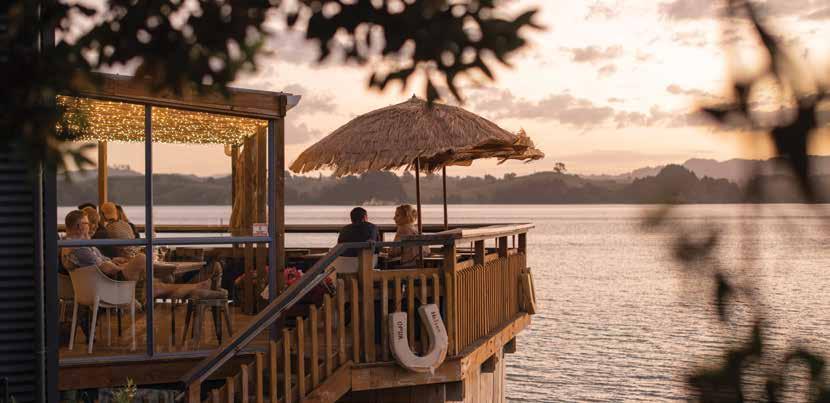
A stroll along the Wharfside Ōhope is Maria’s pick, where you can enjoy live music, kai, drinks, and bombs off the wharf!
If you are staying in Ōhope, Natasha recommends Ōhope Beach Top 10 with its variety of accommodation offerings and, she says, “amazing spa and views of Whale and White Island.”
Two minutes from Ōhope is Tio Ohiwa Oyster Farm, Takeaways and Tours. Megan says, “Book one of their harbour tours and discover Ōhiwa's rich history, oyster farming, cultural significance and stunning harbour. Experience the ocean’s bounty first hand, learn the art of shucking oysters before getting to taste them. Or you can simply order fresh oysters or fish and chips from their takeaways.”
Colin sums it up when he says “Whakatāne and the Eastern Bay is a hidden gem, with so many amazing spots to explore and enjoy, we are never short of places to go, walks to enjoy, and great food stops along the way. There is too much to see in a day, so well worth a weekend or longer to truly appreciate what the area has to offer.” While you are in town pop in to Colin’s store The Good Tonic, 36 Boon Street.
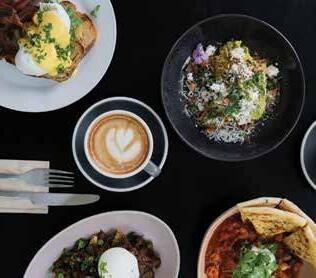


ESCAPE THE CITY Tranquil setting - Fairtrade coffee - Delicious food Kids play area - Dog Friendly 7 Clarke Road, Te Puna – 552 44405 www.clarkeroadkitchen.co.nz NEW MENU COMING SOON PAGE 15 | WWW.NOURISHMAGAZINE.CO.NZ




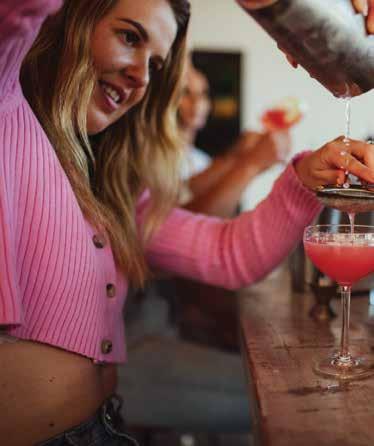
flavours of plenty festival returns
PAGE 16 | WWW.NOURISHMAGAZINE.CO.NZ

The award-winning Flavours of Plenty Festival returns to the Coastal Bay of Plenty this April with a menu of events to excite and inspire. From a seafood soirée like no other at Trinity Wharf to the Four Hands Dinner with Chef Neil Sapitula from Solera and Chef Sun Peng of Amisfield, the festival’s organisers have been preparing a programme full of enticing culinary collisions.
“Hot on the back of our amazing double-win at last year’s New Zealand Events Association annual awards, our 2024 festival will have long lunches, degustation dinners, and everything in between!” says Festival Director Rae Baker. “This is our third festival and we know that foodie fans will savour the chance to explore the secrets behind the unique and tasty treats our region produces and will enjoy picking up some handy culinary skills at one of the workshops.”
The programme, which is managed by Tourism Bay of Plenty, includes over 40 events with some past favs like Kitchen Takeover and Bee First Apiaries hands-on experience, Fife Lanes Flavours of Plenty Luncheon, the Mount Main Street’s roaming lunch, and the very popular “Battle of the Snack” at Saltwater Seafood Grill & Oyster Bar.
The theme for this year’s festival is ‘Culinary Collisions’. Rae says, “It’s all about creative collaborations, where chefs, producers, artisans, and food enthusiasts unite to craft and savour remarkable taste experiences.”
‘Five Go Wild with Food’ is one shining example of this with Ian Harrison (Sugo), Perrin Yates (Sailor, Hide, and Brew Co.), Neil Sapitula (Saltwater and Solera), and Masterchef’s Kasey and Kārena Bird joining forces for a unique event held at the new St Amand Events Venue in Tauranga where each chef crafts one course using mystery box ingredients, resulting in a 5-course culinary extravaganza.
Other awesome collabs see local eateries and producers joining forces. If gin is your thing you can choose ‘Dabbler's Degustation’

at Oscar and Otto or an evening of sweets and spirits at But First Dessert. While Fife Lane are pairing local brews with beef.
The Plates a Plenty Challenge, where local eateries transform local ingredients into a winning dish, is also back. This awesome challenge not only highlights incredible local ingredients along with the talent and creativeness of local eateries' culinary teams, but it also offers the public a chance to literally take a bite.
The festival not only offers you a chance to taste new things, you can also learn new tricks.
Unleash your inner pitmaster at ‘The Big Smoke BBQ Masterclass’ or get hands on learning to make your own salami. Mix it up with one of the cocktail making workshops or even craft your own gin.
Or get carried away on an adventure to truly remember. Join the Tio Ōhiwa Oyster Cruise, a 2.5-hour culinary and cultural voyage, delving into the rich Māori history of the lands. Gain insights into oyster farming and participate in shucking your own oysters at the farm.
Join Virginia Jeeves from Epic Whakatāne on a whimsical mystery bus tour, indulging in a day filled with delightful surprises.
Immerse yourself in a culinary experience that transcends borders and captivates the senses with Lantern's ‘Journey Through Southeast Asia’. Don your best Norse attire for Latitude 37's ‘Flavours of the North: Sizzle & Stein Sunday Festival’, a Vikingthemed culinary extravaganza.
Join Avocado Tours for an immersive exploration of a working avocado orchard or uncover the rich history and innovation of horticultural champions, including kiwifruit, avocados, bees, and honey at Western Bay Museum's latest exhibition, ‘The Food Bowl of Plenty’.
Be sure to grab your tickets to at least one of the delectable events and immerse yourself in unforgettable culinary experiences that showcase the incredible ingredients and cultural richness of the Bay of Plenty.
www.flavoursofplentyfestival.co.nz
NOURISH | FEATURE PAGE 17 | WWW.NOURISHMAGAZINE.CO.NZ
A New Wave OF FOODIES
WORDS VICKI RAVLICH-HORAN
Whangamatā has long been a hot spot for the quintessential Kiwi holiday. With its beautiful beaches, great fishing, nearby bush walks and mountain biking trails this is a town where the humble bach still outnumbers the sandcastle mansions.
As any ardent Whangamatā fan will tell you, this beachside town has so much going for it, you don’t miss the lacklustre culinary scene. Don’t get me wrong, there are some standouts, like Port Road Project, along with some eateries hitting the right mark with the casual beach vibe and consistency many beachside establishments struggle with. This summer we had a delicious meal at Rassasay, and we always enjoy a quick casual bite at Craft Haus and Smoky Pallet.
In recent years there has been something in the air. It started with Simon Wright moving to town and opening Gather & Roam. Suddenly foodies from around the country began to visit Whangamatā for more than the surf. More recently the pop up bakery Rüdi’s created ripples, and long queues only ever seen outside the fish n chip shop on a Friday night began to form early each morning as punters queued for delicious pastries and breads. Rüdi’s has since moved to Hamilton, while Simon is Head Chef at Clarence in Tauranga. And although these trailblazers have left town, in their wake is a growing sense of pride, not to mention a growing number of foodie businesses giving us another compelling reason to visit this town.

SALT DISTRICT
We first met Liam from Salt District Brewery at the start of last year just after he had opened their cellar door. Tucked down an alleyway off the main street, Salt District are open Thursday, Friday and Saturday afternoons for you to fill a flagon with one of their staple or seasonal brews. “The cellar door isn't just a tasting room,” says Liam, “it's a hub of camaraderie. A place to meet fellow beer enthusiasts, exchange stories and share surf reports in a laid-back welcoming atmosphere, and footwear is optional.”
Discovering his love of craft beer when travelling in the States in his early twenties, Liam recalls, “I had a Sierra Nevada Pale Ale and it just totally blew my mind.” Back in New Zealand he took up a trainee brewer position at bStudio in the Hawke’s Bay and spent the next two years learning his craft and surfing, or some would say, living the dream.
Back in Whangamatā and homebrewing with his friend Kehan, the pair decided to turn a yoga studio into their HQ. With Covid lockdowns a thing of the past, what could go wrong?
Salt District had only had their doors open a few weeks when cyclone Gabrielle knocked out state highway 25. Liam says, “Looking back now it was kind of a great period to really focus on our processes, dial in our equipment, fine tune some recipe development and to continue learning as much as possible.”
Fast forward to this summer and Liam says, “Once the Christmas weather forecast was locked in and the hordes of people turned up, it was the best feeling, a great confidence boost for our small business and with customers loving our beer, branding and ethos it has really made us realise we are potentially onto something viable for the long term.”
PAGE 18 | WWW.NOURISHMAGAZINE.CO.NZ
To extend the summer season and continue to grow the community vibe, Salt District plan to host a number of events in their courtyard. These, Liam says, will involve food trucks, live music and, of course, slinging suds. There are also plans for some canning runs of the core range which Liam admits “will be really exciting and probably a little surreal to see them on the local supermarket shelf”. They also have a re-brew of the famous Coromandel chocolate porter, so watch this space.
You can enjoy a Salt District brew by filling a flagon at their cellar door or by enjoying a pint at a number of local eateries like Port Road Project, Craft Haus, Six Forty Six Café, Whangamatā Golf Club and Rassasay Restaurant.
Salt District Cellar Door, 101B Winifred Ave, Whangamatā
COROMANDEL CHOCOLATE
Frenchman Thomas Capdevielle’s passion for his craft and adopted hometown is infectious. Thomas and wife Jess started Coromandel Chocolate in February 2023. In just one year they have quickly grown and recently opened a shop in town. And although Thomas talks about great chocolate taking time, I get the impression he is not one to sit back and wait.
Thomas has spent a decade gaining the skills he needs to be a great chocolatier, while also refining his vision for the chocolate company he wanted to own, and knew it had to be based in Whangamatā – where he and Jess met and where they want to raise their family.
After four years studying at a prestigious chocolate academy in Southwest France followed by apprenticeships with some of France’s leading chocolatiers, the Capdevielle’s moved back to New Zealand. Here Thomas worked with Honest Chocolate before it was time to go out on his own.
A small but perfectly formed chocolate factory was built in front of the couple’s home. While some equipment needed to be imported, a 700kg, 1950s roasting machine originally from Kawau Island which had found its way to Kerikeri and had sat idle for years was brought to Whangamatā and resurrected with help from Pieter van Leeuwen (from the Coromandel Cheese Co).
Roasting the beans is a key step in the chocolate making process, but what Thomas believes sets Coromandel Chocolate apart is they have control of the product not just from roasting the bean but before the bean arrives.


Coromandel Chocolate exclusively uses cacao beans from Meluka Island in Vanuatu, where their plantation boasts cacao trees that are 30–35 years old, flourishing under mango and banana trees.
The cacao fruit ripens to a yellow colour and develops delightful berry, dried fig and banana flavours. After being handpicked the cacao beans are fermented for 8–10 days before being dried and then dispatched to Whangamatā.
“Why import cacao beans from elsewhere when we can invest our money right here in the Pacific?” asks Thomas. “Our goal is to raise the profile of Pacific single origin cacao and give it the recognition it deserves.”
While making a delicious product, Thomas is on a mission to shine the light on the dark side of chocolate while offering an alternative. “At Coromandel Chocolate, we truly want to help people understand the power they have by supporting small scale chocolate makers and cacao farmers.”
Coromandel Chocolate Boutique, 100 Hunt Road, Whangamatā, open Friday–Tuesday 9am–5pm coromandelchocolate.co.nz
NOURISH | FEATURE The ultimate dessert experience Available every Sunday, bookings essential www.butfirstdessert.co.nz Dessert High Tea PAGE 19 | WWW.NOURISHMAGAZINE.CO.NZ
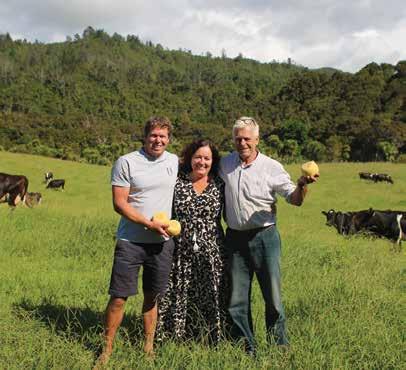
COROMANDEL CHEESE
A few kilometres north of Whangamatā is the van Leeuwen’s 60-hectare dairy farm. Originally from Holland the family moved to Coromandel in 2001 to enjoy the lifestyle the area offered. With their Dutch heritage and an abundant supply of fresh milk, the van Leeuwen’s had always made cheese for friends and family. It was youngest child Marten’s idea to make the cheese to sell. And so, four years ago, Coromandel Cheese was born.
Pieter and Sabina (aka Dad and Mum) are the farmers and cheesemakers while son Thijs and daughter in law Lisa have established ‘The Little Dairy Company’ to market and sell the cheese and future products. “I have to tell them to slow down,” Pieter laughs, “as we don’t have the storage facility.”
Pieter has ingeniously converted some shipping containers into the cheese factory. There are plans in place to expand this to include yoghurt making facilities plus room to age and store more cheese.
The family’s herd of 90 pure bred Holstein Friesian cows are milked year-round and graze only on grass. They have been bred to all have the A2A2 genetics. Lisa, who spends most of her weekends at markets selling the cheese says, “people love it”. And believes the A2A2 milk is a real advantage with customers who haven’t been able to eat cheese for years enjoying Coromandel Cheese.
Sold in very cool 1/2kg rounds, this beautiful cheese makes a gorgeous centrepiece to a cheeseboard or antipasto platter. But the van Leeuwen’s are adamant that their cheese is not just for special occasions, and part of the ethos from the start was that it needed to be a fair and affordable price for all.
The range currently consists of five flavours, the original –Kawakawa with its leaves picked from nearby Onemana beach – along with plain, chilli, cumin, and fenugreek. A more aged cheese is on the cards when room allows for cellaring and so too is a strained yoghurt. In the meantime, the family are working on online orders and deliveries, so those who can’t visit them at the markets can still enjoy their cheese.
You can find Coromandel Cheese at local markets most regularly at Waihī Beach Farmer’s Market, Hamilton and Cambridge Farmer’s Markets and the Howick Village Markets. Keep an eye on the website: thelittledairycompany.co.nz.

CAMINA
This Spanish-style eatery opened just before Christmas and has quickly become the hot ticket. Co-owner Rowan Crowe says, “The first two months have been incredible; we have been fully booked out every night. We didn't really know what our expectations were but whatever they were they have been completely blown out of the water.”
Rowan and co-owner Barend Beukes have both called Whangamatā home for several years. Rowan moved the family to Whangamatā from Devonport in 2020, wanting to raise his children around family and so that they could grow up surfing and enjoying small town life.
Barend, who is originally from South Africa has cheffed around the world, including Michelin starred restaurants in England and superyachts in Sapin. When he moved to New Zealand he worked with Jason Scott at Scotts Epicurean in Hamilton, following Jason to Whangamatā when he started Port Road Project seven years ago. Rowan, who worked in the building trade after moving to Whangamatā, says, “My love for people made me want to do something different and when Barend presented his idea of doing the restaurant with me, I jumped at the opportunity.”
Those building skills were to come in handy as they transformed the iconic cinema building that, until recently, the only culinary memories it would conjure up were of tangy fruits or crushed jaffas. Camina includes a warm, intimate dining room and casual laneway gathering space, making it the perfect spot for drinks with friends or a refined night out.
In keeping with the Spanish theme the menu gives a nod to traditional tapas, all perfect to share – except the Coromandel Chocolate s’mores, that one you’ll want to keep to yourself!
Like the s’mores, the food is centred around fire, with locally sourced produce shining.
The majority of their fresh produce comes from Pākaraka permaculture garden just outside of Thames. Rowan says, “We feel so grateful to have such incredible produce from such amazing people so close to the restaurant. Seeing it turn up and then on people's plates so soon after it got pulled from the ground is very special.”
Camina Restaurant & Bar 708 Port Road, Whangamatā www.camina.co.nz
PAGE 20 | WWW.NOURISHMAGAZINE.CO.NZ
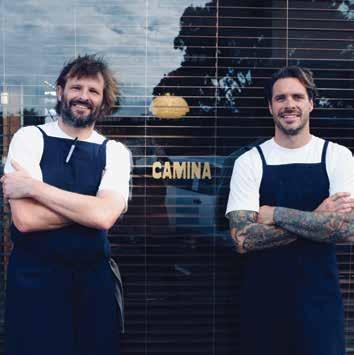

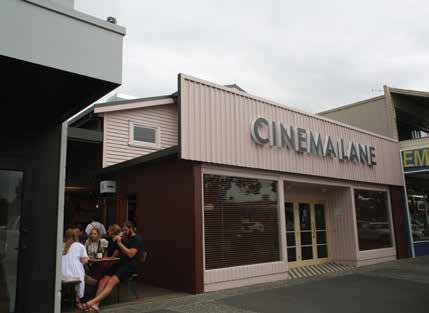
NĀHANA HONEY
Husband and wife Mike and Tanya Ward moved to Whangamatā in 2013, where they established 50 beehives. The hives thrived in the warm climate and now number over 1000, plus those of parents, siblings, children, cousins, and friends, making up this true family business.
Mike’s interest in beekeeping began on his parents’ property in Makakahi Valley near Mt. Ruapehu where the mānuka covered hills offered an opportunity to find a complementary income for the multi-generational farm. As he has learnt the craft, and the couple have built the business, they have done so with a community of friends, family and neighbours around them.
Around two years ago they launched the brand and began selling their honey to the public. They called the new beekeeping venture Nāhana (meaning ‘belonging to him or her’) as an ever-present reminder of their role as stewards of the land, working to leave an even better legacy for future generations.
Tanya says, “In essence, honey is a lot like wine in many ways –the area the honey comes from has a significant impact on the taste.” The terroir of honey is especially noticeable in honeys like Nāhana, where there has been minimal processing or heating.
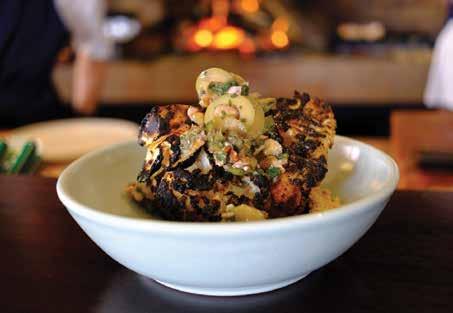
Tanya says their Native Honey is a good example of this. Often labelled 'Bush Honey' by other brands, Nāhana Native honey, according to Tanya, “has the distinct flavour of rewarewa [which grows well in the Coromandel with its warm weather and low alpine ranges] paired with the smooth sweetness of kānuka. Both are sought after honeys on their own and together they create a truly delicious honey.”
In addition to their Native honey, Nāhana have a Mānuka honey sourced from the family farm in the Central North Island, along with a Pōhutukawa honey and Multifloral Mānuka honey, which are also harvested from the coast surrounding Whangamatā.
Look out for Nāhana Honey at Coromandel Chocolate on Hunt Road and a growing number of outlets. www.nahana.co.nz
thecoromandel.com
PAGE 21 | WWW.NOURISHMAGAZINE.CO.NZ
BRILLIANT BEETROOT
WORDS RACHEL HART
Growing up in Canada, beetroot didn’t often feature on my dinner plate. It would show up in the odd salad, and my Polish ancestry meant I had heard of borscht – the ruby red Slavic soup – but I had certainly never seen beetroot on a burger. That is, not until I moved to New Zealand.
I now know that beetroot on a burger is as classically Kiwi as pavlova, feijoas and mince pies. But back then, whether I sat down at a burger joint or at my mother-in-law’s dining table, finding beetroot on a patty was a revelation. The colour! The juiciness! The earthy sweetness! Plus, I loved how it snuck a dose of nutrition into a meal of burgers and chips.
Looking at a beetroot, you just know it’s healthy. The first thing you’ll notice is the dark purple hue; peel the skin to reveal a brilliant vibrancy which will leave your hands stained for days. The pigments responsible for the deep reddish-purple of plants like beetroot, bougainvillea and dragon fruit are called betacyanins, and like pigments found in all brightly coloured fruit or vegetables, they have antioxidant properties that help protect the cells in our body from damage.
If the purple colour alone isn’t enough to convince you of their health status, the lush stalks and stems will. Even though they grow underground, beetroot is in the same family as spinach and Swiss chard, making them both a root vegetable and a leafy green – talk about a superfood! And finally, just in case anyone still has doubts, there’s the smell – that earthy scent of a vegetable grown beneath the soil, soaking up nutrients before it pushes up past the dirt.
Considering the mounting evidence, it's hardly surprising to discover that beetroot boasts a wealth of health benefits. Beetroot is mostly made up of water and offers a decent dose of fibre and a whole host of vitamins and minerals. Notably, it is high in B vitamins, vitamin C, folate, and manganese.
Beetroot is also rich in nitrates, which improve blood flow and bring more oxygen to the body, potentially lowering blood pressure and helping with muscle recovery. And it’s particularly high in glutamine, an amino acid that boosts digestive health and helps protect the gut from injury and stress.
While beetroot is indisputably healthy, what’s less obvious is how versatile it is. In my experience, Kiwis tend to boil beetroot and either serve it straight away, or pickle it for later use. While boiled beetroot is delicious, there are other options.
Roasting beetroot will bring out its natural sweetness, while steaming it retains more of its nutrition. You could also slice it paper-thin to create a striking layered salad, or grate beetroot and toss it into a coleslaw, turn it into relish – another Kiwi staple – or mix it into batter for an unbelievably moist chocolate cake. There are plenty of ways to elevate your beetroot game, but I will always maintain that there’s no better use for this sweet, juicy, nutritious vegetable than on a classic Kiwi burger!

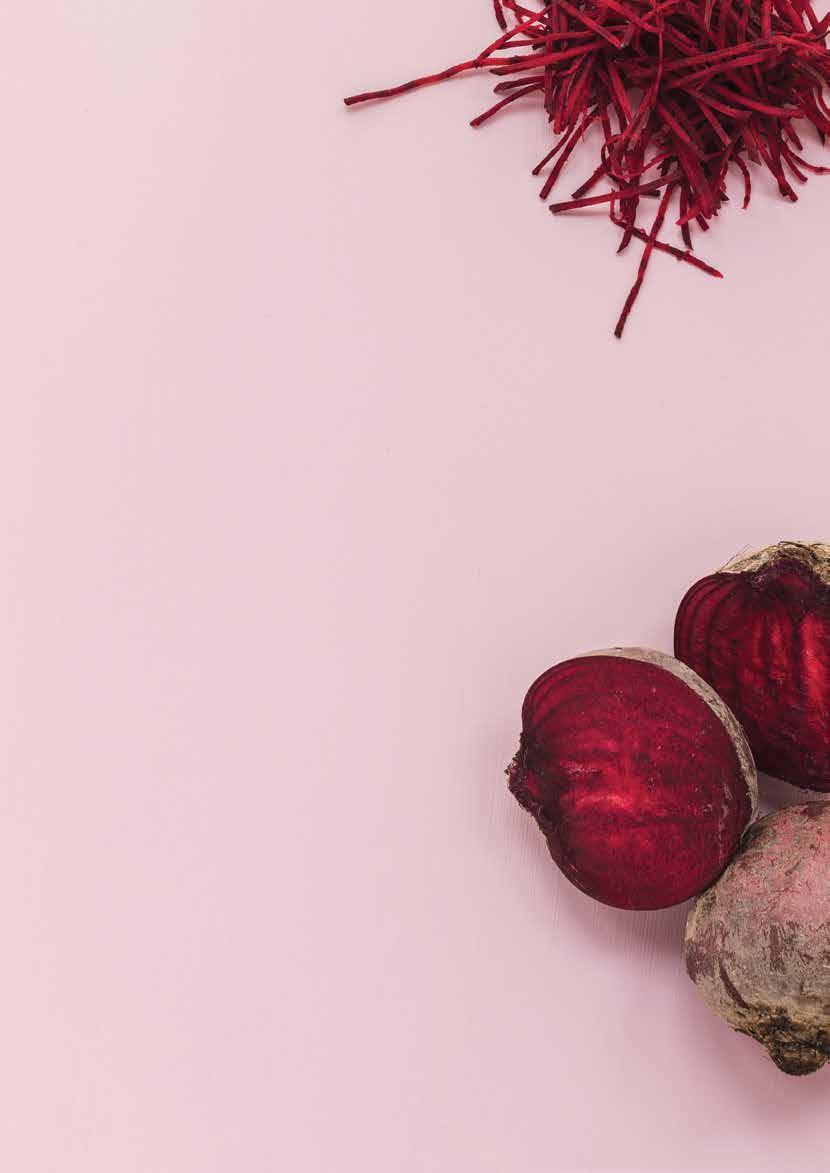 Rachel Hart
Rachel Hart
Hailing from Canada, Rachel has fallen in love with life in the beautiful Bay of Plenty where she is a freelance writer with a passion for healthy food. She splits her time between telling people’s stories, creating web content and experimenting in the kitchen.
NOURISH | NUTRITION
PAGE 22 | WWW.NOURISHMAGAZINE.CO.NZ

Unbeetable

Fresh beetroot is an often overlooked vegetable which intimidates many, and while I love a slice of good ol’ tinned beetroot as much as the next person, there’s something truly magical about growing or buying whole beetroot and preparing them yourself. Whether that means grating and eating raw, juicing, boiling or roasting, its earthy sweetness can’t be beaten.
NOURISH | RECIPES PAGE 23 | WWW.NOURISHMAGAZINE.CO.NZ
RECIPES & IMAGES EMMA GALLOWAY
Beetroot and Carrot Salad with Pomegranate Dressing
My dad grows THE BEST beetroot. Every year without fail he produces huge, tender beetroot of different sizes and colours. I, on the other hand, can only seem to manage to get one specific variety to grow (golden beetroot for those wondering) and all others turn tough and woody, seemingly overnight. Recently Dad grew long cylindrical beetroot, the kind that are perfect for bottling/canning. They were so tender and sweet I couldn’t bare do anything else with them other than prepare and eat them raw. This salad is a nod to my 80s hippy childhood, where beetroot and carrot salads were a regular feature.
SERVES 4–6
2 medium beetroot, peeled
2 small carrots, peeled
generous handful of coriander leaves and tender stems, roughly chopped
TOASTED SEEDS
¼ cup sunflower seeds
¼ cup pumpkin seeds
2 tbsp sesame seeds
1 tsp soy sauce (gluten-free if needed)
1 tsp olive oil
POMEGRANATE DRESSING
1 tbsp honey or raw sugar
2 tbsp pomegranate molasses (available from Vetro)
2 tbsp balsamic dressing
2 tbsp lemon juice
¼ cup extra virgin olive oil
salt & pepper
Finely shred beetroot and carrot using a mandolin or grater and place into a bowl with the coriander. To make the toasted seeds, combine sunflower, pumpkin and sesame seeds in a small frying pan over medium heat and cook while stirring until lightly toasted. Add soy sauce and olive oil and stir for a further 20–30 seconds until the mixture is dry. Remove from heat and transfer seeds to a bowl.
To make dressing, combine honey/sugar and pomegranate molasses in a small bowl and whisk until smooth. Add balsamic and lemon juice and whisk to combine. Continue whisking as you drizzle in the olive oil to


form a lovely, emulsified dressing. Season with salt and pepper to taste. To serve, add toasted seeds to shredded beetroot/carrot mixture, stir through as much dressing as you like. Taste and adjust seasoning, then serve.
Roasted Beetroot Salad with Mustard Caper Dressing
I LOVE raw beetroot salads, but as with most root vegetables, roasting intensifies its natural sweetness.
SERVES 4–6
6 medium beetroot, ends trimmed
2 small red onions, peeled and cut into wedges
olive oil
salt & pepper
2 radishes, thinly sliced
¼ cup pumpkin seeds, lightly toasted
50g feta cheese, crumbled
2 handfuls micro greens or mesclun salad greens or rocket
MUSTARD CAPER DRESSING
1½ tsp Dijon mustard
1½ tsp honey or raw caster sugar
1 tbsp lemon juice
1 tbsp red wine vinegar or apple cider vinegar
¼ cup extra virgin olive oil
1 tbsp capers, drained and finely chopped
Preheat oven to 200°C. Cut beets in half, then into bite sized wedges. Place on an oven tray with the red onion wedges, drizzle with olive oil, season with salt and pepper and roast 20–25 minutes or until tender and charred in places. Remove and set aside to cool slightly.
To make the dressing, combine mustard and honey in a small bowl, add lemon juice and vinegar and whisk. Continue whisking as you drizzle in the olive oil. Add chopped capers and season to taste with salt.
Combine roasted beetroot, onions, sliced radishes, toasted pumpkin seeds, feta cheese and micro greens/mesclun/rocket in a bowl. Drizzle over enough dressing to coat and serve immediately.

At the Pacifica Complex
112 Tara Rd, Papamoa
p (07) 542-0190
www.pacificapapamoa.com whiteginger_pacifica
PAGE 24 | WWW.NOURISHMAGAZINE.CO.NZ


Emma Galloway
mydarlinglemonthyme.com
@mydarlinglemonthyme
Emma Galloway is a former chef and creator of the multi-award winning food blog My Darling Lemon Thyme. She is the author of three best-selling cookbooks, which focus on flavour-packed everyday recipes that happen to be vegetarian and gluten-free.
PAGE 25 | WWW.NOURISHMAGAZINE.CO.NZ

PACK A PICNIC
WORDS HARRIET BOUCHER | IMAGES BRYDIE THOMPSON PAGE 26 | WWW.NOURISHMAGAZINE.CO.NZ
We picked up the gorgeous green blanket from The Heritage Trading Co.

There’s nothing quite like an autumn day with clear blue skies, gorgeous colours on the trees, and the sun streaming down. It’s the perfect time to grab a basket, a blanket, and a few drinks and find the perfect spot to enjoy these recipes.
The trick to packing the perfect picnic is choosing food that can be made ahead of time and is easily transportable. If it can be eaten without cutlery, even better.
HERBY LEMON CHICKEN DRUMSTICKS
My mum, Tracey, always made chicken drummies for family picnics when we were younger. They’re fabulous hot or cold and have their own little handle so you don’t need cutlery!
10 chicken drumsticks
zest and juice of 1 lemon
¼ cup olive oil
1–2 cloves of garlic, crushed
¼ cup finely chopped fresh herbs (mix of rosemary, oregano, thyme, parsley)
salt & pepper
3–4 tbsp flour (optional)
Cut around the skin and meat at base of the chicken drumstick using a
small sharp knife, then push the meat up to expose the bone and create a lollipop look. I love doing this as the meat stays tender and the bone dries out when cooking which makes it a bit cleaner to eat.
Mix together the lemon zest and juice, olive oil, garlic, herbs, and a good grind of salt and pepper. Pour over the chicken drumsticks and allow to marinade for at least an hour or overnight.
Preheat the oven to 200°C.
Transfer the chicken to a baking tray. If desired, sprinkle a little flour over the skin of the drumsticks for extra crunch. Cook for 20–30 minutes or until fully cooked through and golden, turning once during cooking. The timing depends on the thickness of the drumsticks.
The drumsticks can be eaten hot or cold. If you’ve cooked them just before setting off, pop them into a container and straight into your basket. If you’ve cooked them in advance, allow them to cool in the fridge before popping the lid on the container.
NOURISH | RECIPES
PAGE 27 | WWW.NOURISHMAGAZINE.CO.NZ
CURRY POPCORN
I was lucky enough to go to Tokyo Disneyland as part of an intermediate school exchange. My standout memory from there was the savoury-sweet curry popcorn, so this is my attempt to recreate it. You could get away with using 50g of butter; I just love buttery popcorn.
2 tbsp neutral oil
¹⁄³ cup popcorn kernels
75g butter
2 tsp curry powder
1 tsp flaky salt
2 tsp sugar
Heat the oil in a large pot, over medium-high heat. Add the popcorn kernels and shake to coat in the oil. Cover with the lid so you don’t end up with popcorn on the floor. Shaking often, allow the popcorn to cook until the sound of the popping slows down.
Melt the butter in a small pot, then add in the curry powder and salt and stir to combine. Sprinkle the sugar over the popcorn, pour over the curry butter and shake the pot (lid on) vigorously to coat the popcorn.
Place the popcorn into an airtight container once it’s cooled slightly.
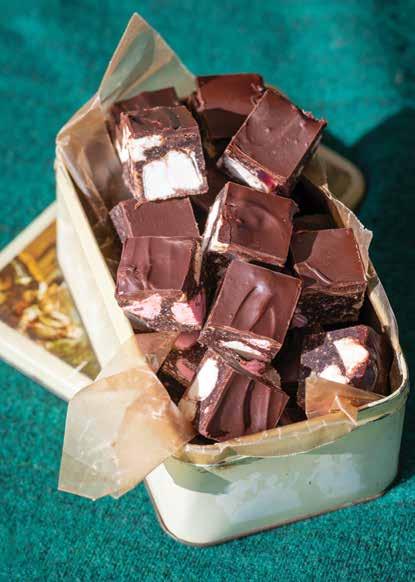
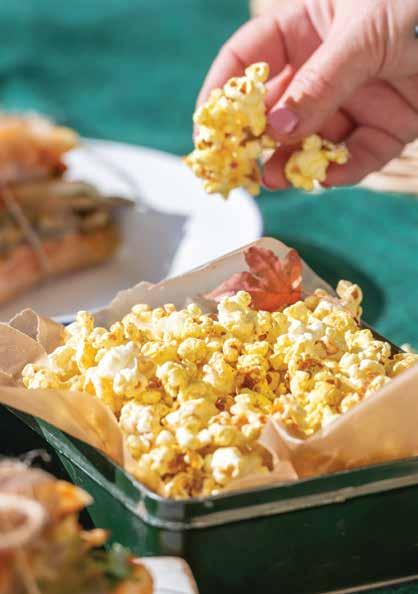
ROCKY ROAD
This recipe is a family favourite of Vicki’s that never lasts long. I convinced her it had to go in the picnic recipes as it’s the perfect sweet treat for any occasion.
FOR THE ROCKY ROAD BASE
250g butter
½ cup sugar
½ cup cocoa
1 tsp vanilla extract
500g biscuit crumbs
2 eggs, lightly beaten
180g packet of marshmallows, chopped 180g packet of jubes, chopped
FOR THE GANACHE
200g chocolate
¼ cup cream
In a pot melt the butter, sugar, and cocoa together. Mix in the remaining ingredients, stir well until evenly combined and press into a lined tin. Place in the fridge for at least 30 minutes to set before making the ganache.
For the ganache, chop the chocolate into small pieces. Place the chocolate and cream into a bowl set over a pot of simmering water and allow it to melt together. Stir until smooth, then pour over the rocky road base and leave in the fridge to set for a few hours. Portion into small squares and keep in an airtight container in the fridge.
PAGE 28 | WWW.NOURISHMAGAZINE.CO.NZ

GRILLED VEGGIE PIDE
Each component of this sandwich melds together for the perfect mouthful. I highly recommend making each component, but if you’re short on time, you could buy a sundried tomato pesto.
FOR THE RED PEPPER PESTO
10–12 sundried tomato halves
3 roasted capsicums (make your own or grab a jar from Vetro)
3 tbsp olive oil
1 tbsp tomato paste
FOR THE SALSA VERDE
½ cup olive oil
1 cup of packed herbs (I use a mix of basil and parsley)
2 tbsp capers
1 tsp Dijon mustard
1–2 tsp lemon juice or white/red wine vinegar
FOR THE FILLING
2 zucchini
1 eggplant
1 200–250g block of haloumi
2 large handfuls of rocket or mesclun
extra olive oil for grilling
1 fresh Turkish pide (or a ciabatta) baking paper butchers twine
In a small food processor/blender, blitz the sundried tomatoes, capsicums, 3 tbsp of olive oil, and tomato paste together to form a spreadable pesto. Place into a container and rinse out the blender. In the clean blender, blitz together the ½ cup of olive oil, herbs, capers, mustard, lemon juice, and a pinch of salt.
Slice the zucchini and eggplant lengthways into thin slices. Drizzle the veggies generously with olive oil and season with salt and pepper. Heat up a BBQ, grill pan, or good quality pan until smoking. Grill the veggies until cooked through and charred. Slice the haloumi into thin pieces, then grill until golden on each side (this may be easier in a hot nonstick pan but the grill will also work).
Slice the Turkish pide horizontally. Spread the sundried tomato pesto on the top and bottom of the pide. Add a layer of rocket on the bottom, followed by the eggplant, zucchini, and haloumi. Generously drizzle the salsa verde on top, then place the top piece of pide on. Slice the pide into 5 pieces using a sharp bread knife.
Wrap each sandwich in a piece of baking paper and tie it with some butcher’s twine, then place into a container, ready to pack into your picnic basket.

Quality mediterranean products at everyday prices ROTORUA 1131 Amohau Street, Rotorua • 07 346 0081 TAURANGA 111 Third Avenue, Tauranga • 07 579 9111 vetro.co.nz PAGE 29 | WWW.NOURISHMAGAZINE.CO.NZ

OhOnions!
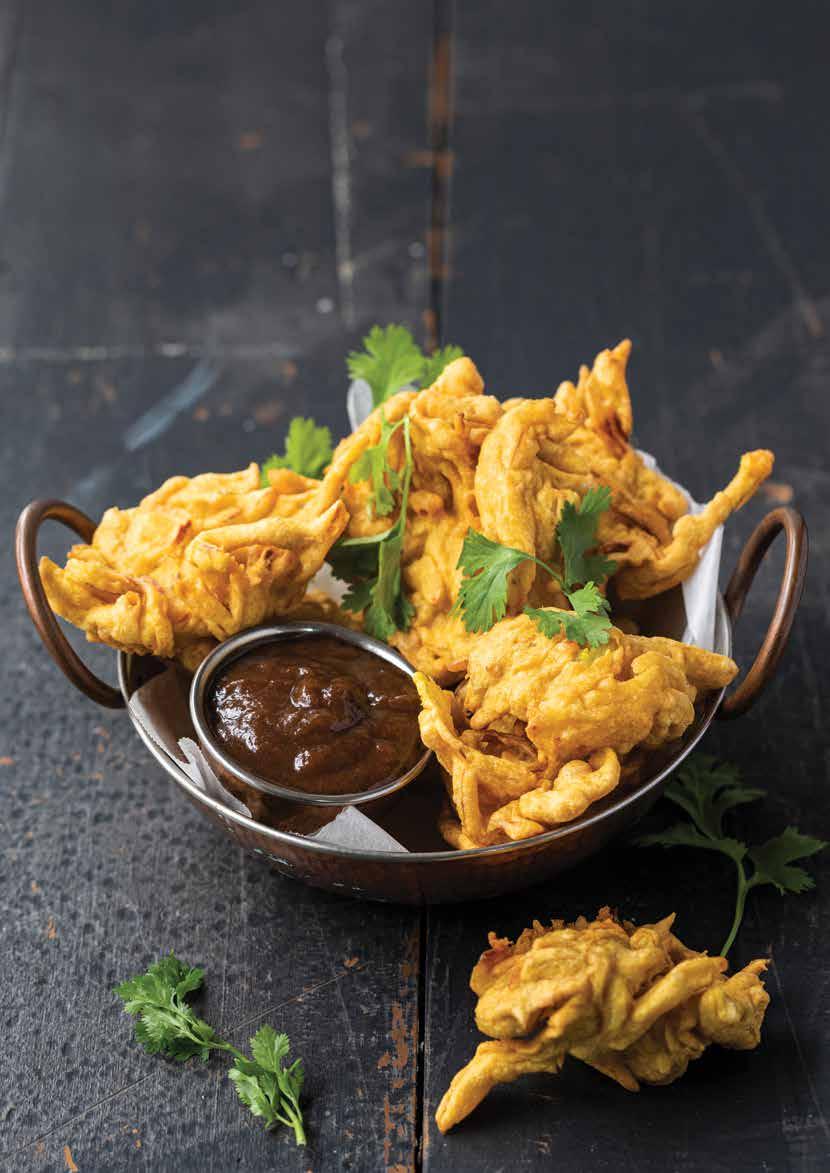
Recipe page 33
The sight of onions floating down the streets of Pukekohe last summer was enough to make you cry. The backbone of so many dishes, onions are loved the world over but seldom as the hero. Sure, the French have their soup, but I say the way for everyone to celebrate the lovely layers of an onion is to fry them. I still remember when I discovered the beauty of an onion ring and can never visit Little India without an order of onion bhajis! So here is my ode to onions with the mantra, don’t cry over onions, fry them!
NOURISH | RECIPES
RECIPES VICKI RAVLICH-HORAN | IMAGES ASHLEE DECAIRES
PAGE 31 | WWW.NOURISHMAGAZINE.CO.NZ
BEER BATTERED ONION RINGS
I’m a sucker for a good onion ring – battered, definitely not crumbed. The beer in this recipe conveniently means there is half a bottle spare for the cook – although I am not endorsing drinking and frying! You can swap the beer for sparkling water which will give you just as light a batter although not quite the same flavour. A teaspoon of cumin seeds is not essential, but a beautiful addition to the batter, especially if you are making these just to munch on with a beer.
1 cup self-raising flour
½ tsp salt
½–1 tsp cumin seeds (optional)
1–1½ cups beer (any will do although I prefer a lager)
2–3 large onions
oil for frying
Place the flour, salt, and cumin seeds (if using) in a bowl. Slowly whisk in 1 cup of beer to form a smooth batter, adding more if the batter is too thick.
Carefully peel the onions, trying to avoid cutting into the layers. Cut the onions into ½ cm rings. Separate the rings, adding the large/medium ones to the batter. The innermost rings can be saved and used next time you need onion.
Heat the oil to 180°C and carefully drop the batter-covered onion rings into the oil. This is best done using tongs and in batches. Also make sure you allow excess batter to fall off the rings before you place them in the oil. Cook the rings until golden, turning them at least once. Remove from the oil and place on paper towels to soak up a little of the excess oil. Season with additional salt if desired and serve.






07 578 1111 76a Grey Street, Tauranga www.tranquillobeauty.co.nz Your Local Skin Experts • Advanced skin treatments • Maintenance treatments • Skincare products #journeybeneathyourskin WE USE ONLY THE FINEST QUALITY SKIN PRODUCTS PAGE 32 | WWW.NOURISHMAGAZINE.CO.NZ
ONION BHAJIS
These are based on Little India’s onion bhajis, where they are a must order.
2 onions, thinly sliced
½ tsp carom seeds, also known as Ajwain seeds
½ tsp cumin seeds
¾ tsp ground turmeric
1¼ tsp salt
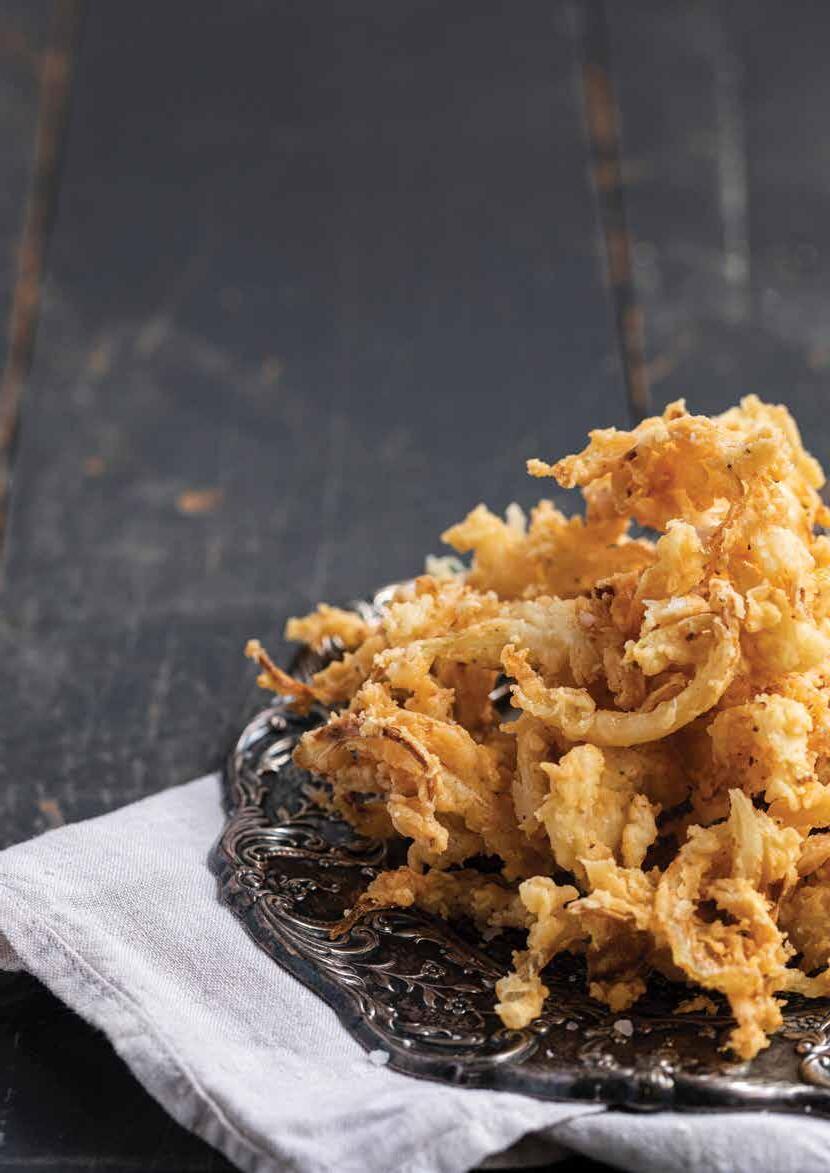
pinch of red chilli powder
oil for deep frying
2 cups chickpea flour (available from Vetro)
¾ cup water
Place sliced onions, carom and cumin seeds, turmeric, salt, and chilli powder in a bowl and stir together.
Add oil to a large pan over a high heat so it is ready for frying when the batter is.
Working quickly, combine chickpea flour and water in a separate bowl to make the batter. Whisk until batter has a smooth custardlike consistency. Feel batter with your fingers and remove any small clumps of chickpea flour. Immediately add batter to onion and spices and stir together with your hands. Do not leave batter to sit as it will go watery and the onion bhajis will not come together correctly in the hot oil.
Make batter and onion mixture into a palm-sized fritter and carefully place in hot oil (the oil is ready when batter dropped into the oil rises to the surface). Repeat with remaining mixture. The bhajis can be a bit fiddly so it is best to fry one at a time. Fry onion bhajis until golden brown.
TAMARIND SAUCE
2 tsp vegetable oil
½ tsp each cumin, cardamom, and ground ginger
½ cup tamarind paste (available at Vetro)
¹�³ cup brown sugar
½ cup water
Heat the oil and spices in a small pot and cook for 1–2 minutes. Add in the tamarind, sugar, and water and simmer.
BUTTERMILK ONION FRIES
This recipe is the delicious combo of the flavours you find in fried chicken and onion rings!
1 large (or 2 medium) onion
1 cup buttermilk
2 cups flour
1 tsp garlic powder
1 tsp onion powder
½ tsp celery seeds
½ tsp white pepper
1 tsp salt
oil for deep frying
Peel and halve the onion, and then with the flat sides down slice the onion thinly vertically. This is often referred to as pole to pole and will result in thin strips as opposed to half rings.
Place the onion slices in the buttermilk and allow them to marinate for at least an hour.
In another bowl mix together the remaining dry ingredients.
Heat the oil in a deep fryer (or large pot) to 180°C.
In batches, dredge the buttermilk-soaked onion in the flour mixture and then place carefully in the hot oil. Fry until golden and crispy. Drain on paper towels and repeat with remaining onions.
Serve while warm and before you munch them all!
PAGE 33 | WWW.NOURISHMAGAZINE.CO.NZ
PEEL OF APPROVAL
WORDS LYNDA HALINAN

PAGE 34 | WWW.NOURISHMAGAZINE.CO.NZ
Oranges and lemons say the bells of St Clements, but not all citrus varieties make our taste buds sing. In the garden – and the kitchen – we all have our favourite squeezes.
The Meyer lemon (actually a citron-mandarin cross) is ubiquitous in Kiwi gardens, hanging onto its golden fruit for three-quarters of the year, but it's a wuss on the flavour front compared to its acidic cousins. For baking and desserts, you need a Yen Ben, Lisbon or Villa Franca.
Mandarins are polarising – do you prefer easy-peel Satsumas or sweet but finger-nail shredding Clementines? But at least oranges don't compete with each other. Navels ripen in winter, while Valencias ripen in summer, so for the longest fruiting season, you need to plant one of each type, plus a bitter Seville for the best marmalade.
Sadly, many orange trees lack the Meyer's dependability and the grapefruit's gregariousness. They can be stingy to fruit while young, so if you buy a property with a gnarly old orange tree, count your blessings.
I reckon I own the biggest orange tree in New Zealand, a tree so tall that it's a local landmark behind our main street bach in the Coromandel township of Tairua. Grown from a pip by the bach's original owners, it's a real sourpuss until late spring, suggesting it has Valencia in its parentage.
If, like mine, your orange tree develops a pattern of biennial cropping, producing a huge haul one year followed by a miserly harvest the next, thin the fruit ruthlessly to reset this habit. (This is true of pears, quinces and plums, too.)
Water oranges frequently from blossom to harvest, and feed twice a year, once in late spring and again at the end of summer. Use a specialist citrus fertiliser with magnesium to green up yellowing foliage.
Incidentally, it's not just the vitamin C in oranges that perks up our spirits. In a former life, I once had a new-age boss who waltzed into my office one day and proudly pinned a sheet of orange cardboard onto my noticeboard. She'd read in some corporate psychology manual that the colour orange increases our energy levels, arouses excitement and inspires creativity, which could explain all the enthusiastic marmalade making and mimosa mixing that goes on in my kitchen.

Lynda Hallinan
Waikato born-and-raised gardening journalist
Lynda Hallinan lives a mostly self-sufficient life at Foggydale Farm in the Hunua Ranges, where she grows enough food to satisfy her family, free-range chooks, kunekune pig and thieving pukekos. She has an expansive organic vegetable garden and orchards and is a madkeen pickler and preserver.
Zesty besties
Fancy an Italian-style potted orangerie? The best variety I've found for planting in pots is ‘Cipo’, a large-fruited but small growing tree that has a natural weeping habit. It's sold as a grafted standard so always looks posh in pots as well as being productive. Order through garden centres.
Navel oranges, so-called because they grow a wee belly button where the blossom detaches from the baby fruit, ripen from July onwards. Choose from Washington or Carter's.
Valencia and its New Zealand descendant, Harwood Late, crop from late spring into autumn.
Blood oranges? Don't bother. They're more of a bloody frustration than anything in our Kiwi climate, as they need a certain mix of hot days and cool nights – at the same time – to kickstart the colouring up process. You may get the odd fruit with ruby-streaked flesh, but don’t bet on it.
Don't fret about the pips. Citrus fruit are notoriously promiscuous cross-pollinators, so the more varieties you plant, the more seeds you'll end up with regardless of whether you choose seedless varieties or not.

NOURISH | GARDENING
ADD THE FINAL TOUCH! These stunning tropical buddhas are a real talking point and colourful addition to a tropical garden or fernery. 80cm high and priced at $489, available from Pacifica Home and Garden Store, 12 Tara Road, Papamoa PAGE 35 | WWW.NOURISHMAGAZINE.CO.NZ

Gather Round the Dining Table
FRENCH PAGE 36 | WWW.NOURISHMAGAZINE.CO.NZ
WORDS LIZ
“Dining with one's friends and beloved family is certainly one of life's primal and most innocent delights, one that is both soul-satisfying and eternal.” – Julia Child
Some of our fondest memories are made when gathered round the table, sharing food and fun. Gone are the days when the dining room was a separate space you only entered at mealtimes. In contemporary interior design the dining area is usually part of open plan living and integral to the social hub of your home. What was formal has become delightfully casual. However, this does not mean sacrificing atmosphere and intimacy.
There are several ways a dining table can inhabit a large space. It may be the free standing centrepiece between the kitchen and lounge. It could be in an alcove with a window seat incorporated. Some dining areas have a mix of fixed seating along a wall and chairs. For an eclectic look your chairs don’t even need to match! Booth seating, popular in the 50s, has again found its way from restaurants to homes. Booths negate the need for chairs and work well in small areas. You can have fun with colour and make the upholstery the hero.
“At a dinner party one should eat wisely but not too well, and talk well but not too wisely.” – W. Somerset Maugham
FUNCTIONAL FLOORING
The dining area is usually adjacent to the kitchen and, as they are high usage areas, flooring is one of the most important considerations, choosing the right product for practicality and to both delineate the space and maintain its cohesion with the rest of the room.
Timber flooring has enduring appeal providing that natural and inviting feel while adding a sense of character to any interior. Hardwood floors add a touch of luxury, while their durability makes them a wise investment. Modern prefinished engineered timber flooring still has a wide range of colours available, from deep, dark, and moody to shades of pale with washes in lime, champagne, and vanilla. In general, dark colours are more sophisticated, while lighter shades evoke relaxation and a beachy atmosphere, ideal for coastal homes.
Timber or tile look solid Vinyl Plank and tiles boast versatility and practicality, and with an amazing array of patterns and colours available now, including timber grain and stone-like finishes. Cost effective, waterproof and easy to maintain, along with its resistance to spills, makes it an excellent choice for families with children and pets … or exuberant entertainers!
Cork flooring is a natural material derived from the bark of the cork oak tree. It’s unique combination of cushioned comfort, sustainability, and durability makes it perfect for dining and kitchen spaces. Add cork’s resistance to allergens, easy maintenance, and design versatility and you have a stylish flooring solution that stands up to the demands of everyday life, while balancing your wellbeing and respect for nature.
DEFINING DINING
The perfect dining space is defined by strategic lighting that focuses the attention on the table and the company. Pendant lighting is a popular choice.


What is under the table can also focus attention on the dining zone. If it is part of a much larger room, a well-placed rug can anchor the space around the table and chairs. Be it round, oval, square, or rectangular, a rug can be chosen or custom made to complement your table’s shape. The many colours, patterns, textures, and materials available allow you to find just the one to make a statement and enhance your dining experience.
A visit to Gerrand Floorings may be all it takes to complete your dining area and ensure it is a favourite gathering space for family and friends.
“One cannot think well, love well, sleep well, if one has not dined well.” – Virginia Woolf
Gerrand Floorings
123 Hewletts Road, Mount Maunganui www.gerrand.co.nz
NOURISH | FEATURE
PAGE 37 | WWW.NOURISHMAGAZINE.CO.NZ

AN EXPANSIVE LIFE ON A COMPACT SITE
LIZ FRENCH | IMAGES BRYDIE THOMPSON & BOUNDLESS VISION PAGE 38 | WWW.NOURISHMAGAZINE.CO.NZ
WORDS

In our burgeoning urban areas land is getting scarcer and site sizes smaller. Medium to high density housing can be achieved without sacrificing quality of life, making rethinking the way we live a liberating experience.
Andra and Andrew Rapley did not move far for a fresh life in a contemporary environment. They now relax in sunshine and seclusion in the courtyard of their new home; right behind their original one in an established central city locale.
Subdividing a property (with all the necessary council approvals) and building a dwelling on the new site is described as an infill project. With the right design and execution, it can be a fulfilling one, as the Rapleys discovered once they involved Thorne Group. Local Māori history meant the subdivision was more complicated than they expected, and Andrew acknowledges it may have been a smoother process had they got Thorne Group on board earlier.
Andra had seen other Thorne Group homes and appreciated the individuality and quality they displayed. A visit to the showhome sealed the deal. Thorne Group’s architectural design partner, Jon McAlpine (TG Architecture), worked with them to create a plan that took in the constraints of the site, maximised the north aspect, and provided solutions to their want list: space for entertaining with seamless access outdoors, an intimate second lounge beside an upstairs master suite with estuary outlook, double garage, storage galore … and even facility for a lift.
The Rapleys appreciated that while Thorne Group’s project management and scheduling was super-efficient and their

attention to detail reassuringly obsessive, they were also flexible enough to allow their clients scope to inject their own personality. The result is a home that genuinely reflects its owners. Andra’s interior design flair is evident in features like the kitchen splashback and the brave use of dark colours as a counterpoint to the light bright interior. She particularly loves the black joinery and stacking sliders that open one corner entirely.
This successful infill project proves that living on a smaller site can gift a larger life. “We have far more time to relax, entertain, enjoy recreational activities and travel while still living in a location we love,” says Andrew.
RESERVE-SIDE TOWNHOUSES
Thorne Group has been ahead of the curve in high density housing, with the late Bob Thorne identifying more than 20 years prior that it was the way of the future with land at a premium.
If their Sands Terraces townhouse development in Papamoa is the future, it’s looking pretty good! With crisp lines and smart profile, they stand out from others in this burgeoning residential zone in Golden Sands, one of the fastest urban growth areas in New Zealand.
While first impressions are important, they must be borne out by design and build factors that ensure residents enjoy long term peace, privacy and quality of life. Hidden features like good acoustics and exceptional sound proofing are as vital as light, sunshine and ventilation, outdoor living, views and onsite parking.
The Sands Terraces border a reserve with an outlook to the Papamoa Hills. Skylights enhance an already bright, airy interior,
NOURISH | FEATURE PAGE 39 | WWW.NOURISHMAGAZINE.CO.NZ



where natural finishes create a cohesive, sophisticated, beachy atmosphere. Greenery plays its part in delineating the homes at the front and enclosing partly covered courtyards at the rear.
The configuration of these homes suggests flexibility and appeal to empty nesters, professionals, as a second or holiday home or for busy families. So convenient too. The comprehensive Sands Town Centre is taking shape within a five minute walk; there is a medical centre close by, local walking and cycling tracks are constantly extending and it’s a pleasant stroll to the beach.
Changes to council regulations are opening opportunities for subdivisions, infill and high density housing. Well-conceived design and planning is crucial to optimising your space. A team of experienced proven professionals like Thorne Group can ensure that downsizing the site you live on is an elevating experience.
Thorne Group
Showhome: 15 Montiicola Drive, Papamoa
The Sands Terraces: Rehua Way (off Carronade Street), Papamoa www.thornegroup.co.nz
Liz French calls her writing deeply superficial as she enjoys creating stories about interesting people, places and property, adventures and animals. Her ample spare time is spent cycling, skiing, walking, reading and haunting cafes. She’s written 35 chapters of her memoir titled “What was I thinking?”
PAGE 40 | WWW.NOURISHMAGAZINE.CO.NZ
LET’S GET IT
Macaron

Not to be confused with the French president or the very simple to make coconut-based biscuit, the macaron epitomises French pâtisserie. These deceptively simple cookies take precision and patience to master and then they require a creative palate to turn them into a taste explosion in one bite.
RECIPE BUT FIRST DESSERT | IMAGES BRYDIE THOMPSON
NOURISH | RECIPES PAGE 41 | WWW.NOURISHMAGAZINE.CO.NZ
The history of macarons has been traced back to a French monastery in Cormery in the 8th century, where it was noted they had the shape of monks' navels. It said they gained popularity in the French Revolution when two nuns, seeking asylum in Nancy, baked and sold the macarons to make a living. At this time the macaron was a simple single biscuit. It wasn’t until the 1930s that macarons sandwiched together with a flavourful filling, or as they were known the ‘Gerbet’ or ‘Paris macaron’, began to appear. This development of creating different flavours and colours has seen the macaron’s popularity flourish. Now seen around the world, they offer bakers two challenges: making the perfect macaron and nailing the flavour.
We asked Adele from But First Dessert to let us in on their secrets to making the perfect macaron, and she went one better in sharing their recipe along with some great tips.
Adele says, “Macarons can be extremely temperamental – too much humidity, overmixing, undermixing, piping etc can all cause them to come out not quite right. We are yet to see a chef that can make a perfect batch of macarons every single time! Practise and finding a technique that works for you is best and you'll be making delicious macarons in no time.”
One of the first things we learned when watching Adele make a batch of macarons is she makes them using an Italian meringue instead of a French meringue. Adele says they think this method makes a beautiful soft and chewy macaron.
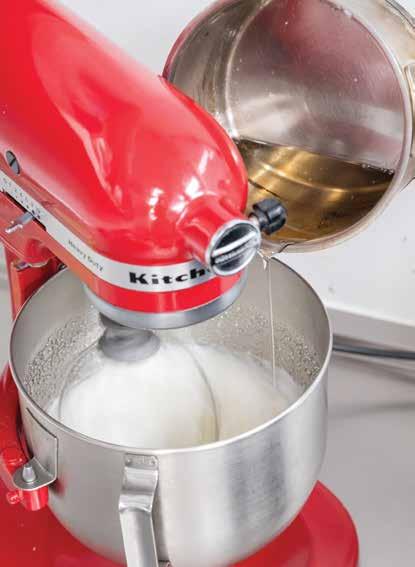

MACARON BATTER
300g almond flour
300g icing sugar
110g egg whites
In a large bowl, whisk together the almond flour and icing sugar until it's nice and smooth (or use a food processor).
ITALIAN MERINGUE
80g water
300g sugar
110g egg white (we recommend using day old egg whites)
Boil water and sugar until 115°C.
Just before the water and sugar reach 115°C, start whisking the egg whites in the mixer.
Take the sugar off the boil and very slowly pour it into the mixing egg whites.
Keep whisking the egg whites until they are almost completely cooled down and come to stiff peaks.
If you're making coloured macarons, add around 1 teaspoon of food colouring (we recommend oil based) to the remaining egg whites and mix well. Add this to the almond flour/icing sugar mix to form a paste.
PAGE 42 | WWW.NOURISHMAGAZINE.CO.NZ
Fold the Italian meringue into the almond batter, being careful not to overmix or to aerate the mix too much.
Once the mix is combined and only running very slightly when left to stand, it's ready to be piped.
At a 90-degree angle pipe each macaron onto a lined baking tray. We recommend using a template under the baking paper to ensure you get perfect macarons every time. When done, simply slip the template out from under the baking paper.
Once all the mixture is piped, leave to sit for 15 minutes. You want each macaron to form a slight shell on the outside.
Once rested and a shell has formed, bake in the oven at 140°C (no fan) for 20 minutes.
When the macarons are completely cooled you can sandwich them together with the filling of your choice. Adele says hands down salted caramel are their absolute best seller and have been from day one.
But First Dessert always have a range of macarons available for you to enjoy with a cup of tea, as part of one of their wonderful desserts or to take away and claim as your own!
But First Dessert Elizabeth Street, Tauranga


TIPS
Use gel-based food colouring. Water based ones will add too much liquid to your mix.
Use leftover egg yolks to make mayonnaise or hollandaise sauce, homemade ice cream or as a binder when making meatballs or hamburger patties. The But First Dessert team add them to their waffles.
Fold the meringue into the almond batter – do not whisk.
Make a template you can use again and again using a cookie cutter to trace around. Adele used a 4.5cm one.
Piping the perfect macaron tacks practice. The key to getting a perfect top is to stop squeezing, twirl then lift off.
For a great range of gel-based food colourings, piping bags, silicon baking mats and more, go to www.sweetpeaparties.co.nz
PAGE 43 | WWW.NOURISHMAGAZINE.CO.NZ

HARRIET’S HOW TO:
Lamingtons
HARRIET BOUCHER | IMAGES BRYDIE THOMPSON PAGE 44 | WWW.NOURISHMAGAZINE.CO.NZ
WORDS
I’m ashamed to admit it, but this all started with a love for Pak ‘n Save lamingtons. I know what you’re thinking, they can’t be that good, can they? Oh, but they are.
The unbelievably light sponge, thin but moist chocolate icing, perfectly textured coconut and a lick of almost certainly fake cream all meld together for the perfect bite. The only ones I’ve tried that are a very close second, if not tied first, are those from the Grumpy Baker in Hamilton.
My friend Carissa worked in the New World bakery when she was younger and let me in on a little (unsurprising) secret that the sponge comes from a pre-mix. I assume this is the case for Pak ‘n Save too, but challenge accepted to try to beat theirs from scratch. Vicki vetoed pink lamingtons, so I put the hard work in to finding the best homemade chocolate lamington recipe.
THE SPONGE:
I started off with Donna Hay’s sponge cake from her Modern Classics book. During my research I discovered that lamingtons are in fact Australian, but Kiwis were the ones who invented the raspberry version, so of course I had to try Donna’s recipe. Her recipe was a simple four ingredients: flour, eggs, sugar, and butter. It was the only recipe I made with butter in it and while it enriched the flavour, I felt it made the sponge heavier. The six eggs made the fresh out of the oven sponge smell like a Sunday breakfast and for an egg hater like me, it was a bit off-putting. This sponge held its height the best, and I made nine generous sized lamingtons out of the mix. I found the flour dominated the senses; a hint of vanilla would have improved the overall taste.
Next on my list was Jackie’s Mum’s Sponge from Stephanie Alexander’s 1000+ page bible, The Cook’s Companion. This sponge is gluten free, using cornflour, custard powder, cream of tartar, baking soda, eggs, and sugar. I was blown away with how light and airy this sponge was, you wouldn’t know it was gluten free. My test tasters were drooling over these lamingtons, but unfortunately this isn’t a practical sponge to glaze. It’s so light that it’s tricky to slice and you must be incredibly gentle when either dipping or spreading icing onto it or the crust just crumbles off. I tried this recipe twice and even freezing the sponge (we’ll get to this soon), doesn’t hold it together enough to make it a feasible option. If you’re looking for a sponge cake to ice whole or you’re gluten free, I highly recommend giving this a go.
I ventured into The Great New Zealand Baking Book next to try Kate Fay’s sponge from her Raspberry Lamington recipe. Her recipe uses flour, baking powder, salt, eggs, sugar, milk, and vanilla. This sponge was light and flavoursome without being eggy or crumbly. It cooked evenly and came out of the tin with no blemishes on the outer.
The final sponge I tried was Vicki’s edited version of the Edmonds Cookery Book. I added vanilla to the ingredient list of eggs, salt, sugar, cornflour, flour, and baking powder. Kate Fay’s cooked more evenly than this, but Vicki’s was my favourite sponge of the four to eat in its plain form. My lamington loving dad had tried a few of my previous recipes and told me “your lamington skills have improved” after eating this one, so I was confident I’d found the right sponge.
As much as I would have liked Jackie’s Mum’s sponge to work, Vicki’s version was the most practical to ice while being the closest to a Pak ‘n Save sponge in flavour. It needs vanilla added to enhance it, but other than that I think she had nailed it. Carissa
had also let me in on a hot tip that her grandma had taught her, which was to freeze the sponge before glazing it. This proved to be a game-changing trick and the quality of the sponge wasn’t compromised.
THE GLAZE:
Going into this research I expected the sponge to be the most complex component, but it was the glaze that had me stumped. When I made Donna Hay’s lamington recipe, I used her chocolate icing, which was the classic icing sugar, cocoa, hot water, and butter. I thinned it out with far more hot water than the recipe specified but I could have made it even thinner. Being a rookie lamington maker at this point, I used a knife to spread it on the six sides of the sponge cube and I don’t think I’ve ever made a bigger mess in the kitchen. This didn’t come close to the Pak ‘n Save lamington glaze, I needed to find one that was pourable, would adhere to the sponge, keep it moist, and possess a deep chocolatey flavour.
Mirror glazes were trendy a few years ago, and I thought one of these might tick my glaze criteria. They’re designed to be so shiny and smooth that when poured over a cake, you can see yourself, hence the name. I tried the Recipe Tin Eats chocolate mirror glaze, which uses water, cocoa, gelatine, cream, and sugar. I found it to be really thick, despite adding extra cream, and I ended up spreading it onto the sponge like Donna’s icing. The cocoa gave a rich chocolatey flavour without it being too sweet so I felt like I was on the right track.
I wanted to try a chocolate-based glaze, which I found on a blog called Chef Iso. This glaze made a HUGE recipe, even after I halved it. It used dark chocolate, water, sugar, condensed milk, vanilla, and gelatine. He recommended adding cocoa if you wanted a dark glaze, but I stuck to just chocolate at first. The consistency of this allowed me to dip the frozen lamington sponge directly into it which made for a far cleaner job. Initially I found it too sweet, but when paired with the sponge and coconut, it balanced well. I added cocoa and extra water to the remaining glaze to thin and enrich it, but the Recipe Tin Eats glaze was still my favourite.
For curiosity’s sake I made a dark chocolate ganache using just cream, chocolate, and a bit of gelatine to help it set on the sponge. It coated the sponge unenjoyably thick, and I found it overpowering, so I quickly dismissed using a ganache.
I went back to the Recipe Tin Eats glaze and halved the gelatin, increased the liquids, and added vanilla bean paste, then modified the method so that I used it whilst still quite warm. This is as close as I’ve got to the Pak ‘n Save glaze and I love the chocolatey flavour it brings to the lamington.
THE COCONUT:
I was surprised by how big of a part the texture of the coconut plays. Over the course of my trials, I used a very fine coconut, thread, and desiccated. The fine coconut was floury in texture, and I really had to press it into the glaze. The coconut flavour was lost being so fine so it ended up being a gritty layer on the palate. Initially I found the thread coconut too dominating, but visually this is the most appealing, and when paired with the right glaze, it brings a welcoming texture and flavour. The desiccated coconut was my favourite all round. It’s the perfect mix between the other two extremes, although visually thread is best.
When up against a pre-mix undoubtedly filled with additives, preservatives, and artificial flavourings, I’m proud of my final lamington. The whole family will love these classic bakery treats. I know I’m addicted.
NOURISH | FEATURE PAGE 45 | WWW.NOURISHMAGAZINE.CO.NZ
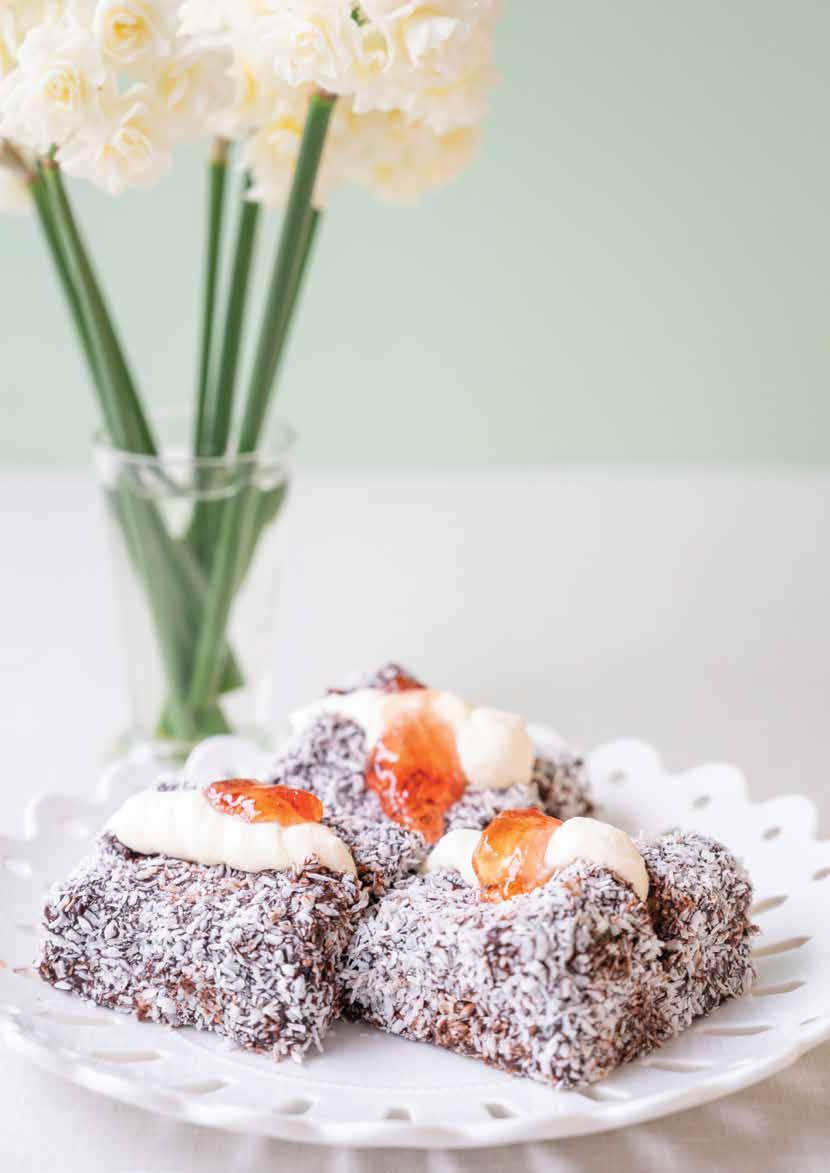
CHOCOLATE
Lamingtons
I’ve fallen in love with lamingtons. The combination of a light fluffy sponge, chocolatey glaze, and coconut are just glorious. I like making 16 smaller ones but if you’re piping cream in the middle, I’d make 9.
RECIPE HARRIET BOUCHER | IMAGES BRYDIE THOMPSON
PAGE 46 | WWW.NOURISHMAGAZINE.CO.NZ
FOR THE SPONGE
3 size 7 eggs
pinch salt
½ cup + 1 tbsp sugar
1 tsp vanilla
3 tbsp cornflour
¼ cup + 1 tbsp flour
1 tsp baking powder
FOR THE SPONGE
FOR THE GLAZE
2 tsp gelatine powder
1 cup water
1 cup cocoa
1 cup cream
1 cup sugar
1 tsp vanilla
2–3 cups of desiccated coconut whipped cream to serve (optional)
Preheat the oven to 180°C (not fan bake). Butter and flour* a 20cm square cake tin.
Beat the eggs, salt, and sugar until thick and pale, approximately 5 minutes, then add in the vanilla and beat well.
Sift together the cornflour, flour, and baking powder, then sift it again over the beaten egg/sugar mix. Use a large metal spoon to fold the dry ingredients in. A tip I learnt at chef school is to gently shake the spoon as you lift the mix over, which helps disperse the flour. Don’t over mix but also ensure there’s no flour pockets left.
Gently pour the mix into the prepared cake tin and place it into the oven. Do not slam the oven door, treat it with respect so you don’t knock the air out. Bake for 15–20 minutes. Don’t open the oven door until 15 minutes has passed. This just helps it have the best chance of staying light and airy. When cooked, the cake will be coming away from the side of the tin and it will spring back when lightly touched.
Allow the cake to sit in the tin for 5 minutes, then tip out onto a wire rack to cool. Once cool, cut into 9 (3x3) for larger lamingtons or 16 (4x4) for smaller lamingtons. Place the sponge squares in an airtight container and freeze for a few hours or overnight.
*To butter and flour a tin, rub softened butter right around the inside of the tin, ensuring you evenly coat it. Add about a tablespoon of flour into the tin and shake it around so it sticks to the butter. Tip out any excess flour and ensure the whole inside of the tin is coated.
FOR THE GLAZE
Sprinkle the gelatin over 2 tbsp of water, give it a stir and allow to bloom.
In a pot, mix the cocoa and water together to make a paste. Add in a little of the cream to loosen the mix, then add the rest of the cream, sugar and vanilla. Place over a medium heat and slowly bring to just below boiling point, whisking to get rid of any lumps. Once hot, take off the heat and whisk in the bloomed gelatin.
Strain into a deep jug or bowl, wide enough to dunk your sponge in and allow to cool for about 15–20 minutes.

Place a layer of coconut on a plate or tray. Gently stick a piece of frozen sponge onto a fork and give it a quick dunk in the glaze. Allow it to drip for a few seconds before prying it off onto the coconut. Roll the glazed sponge in the coconut until it’s fully coated, then place on a clean plate and repeat with the remaining sponges. Top the plate of coconut up as you need it rather than putting it all on the plate at once.
Serve with whipped cream.
TIP: Work with a few pieces of sponge at a time, keeping the rest in the freezer. They defrost quickly and are much easier to work with from frozen. You can also make the glaze ahead of time, just warm it up when you’re ready to use it.

Harriet Boucher
Harriet is a Waikato born and raised foodie. She is a chef by trade and has worked in a few popular cafes and restaurants around Hamilton. When she isn’t whipping up treats, you can find her enjoying a walk along the river or dining at her favourite local eateries.
4 Te Puna Road, Te Puna
Monday to Friday 9am to 4pm
Saturday & Sunday 10am to 3pm www.chalkandcharcoal.co.nz


NOURISH | RECIPES
PAGE 47 | WWW.NOURISHMAGAZINE.CO.NZ
FASHION ACCESSORIES GIFTS BABY
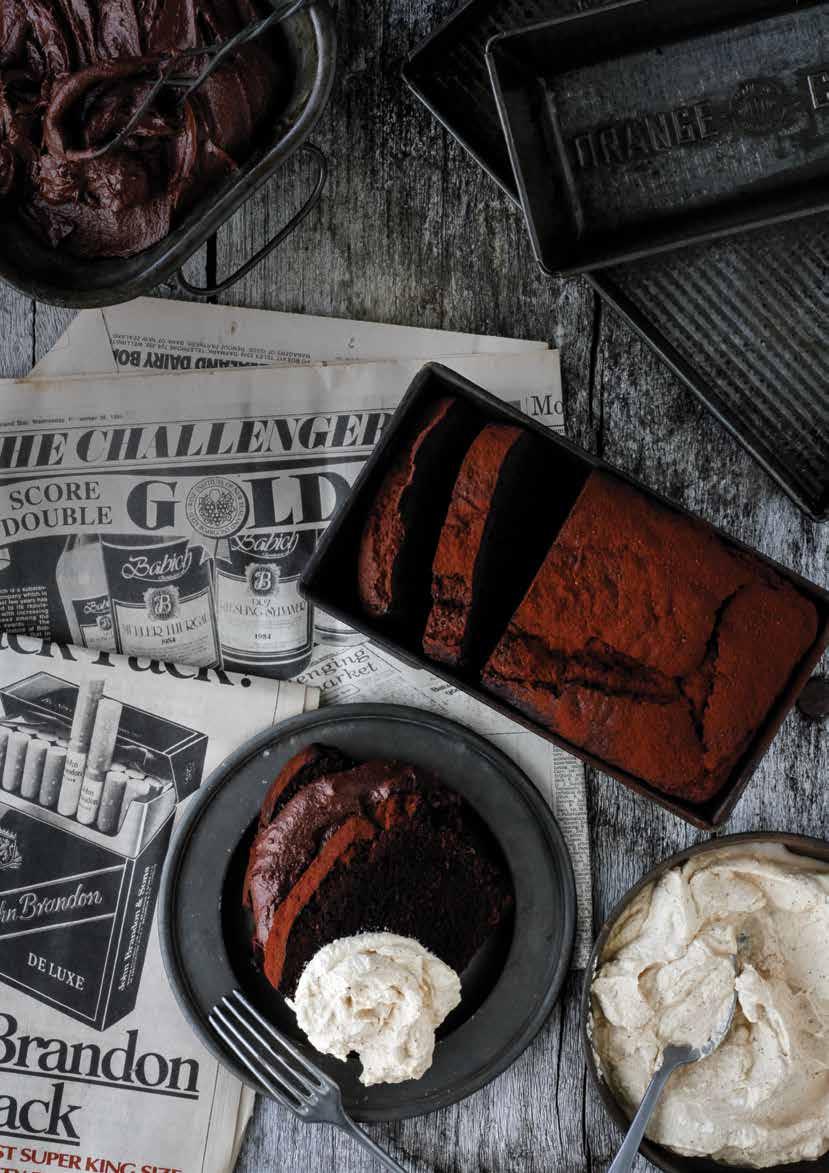
Chocolate Recipes You Will Melt Over
RECIPES & IMAGES FIONA HUGUES PAGE 48 | WWW.NOURISHMAGAZINE.CO.NZ
A LOAFY CHOCOLATE SITUATION (AN ODE TO DKD)
Any young at heart Auckland party goer or night owl student of the nineties will undoubtedly remember DKD café tucked at the back of the Civic Theatre. Named after the trio that started it, Darren, Karen and Derek, I always thought it stood for Decadence Kills Desire. Maybe it did, I don’t care. It’s where you went with the munchies late at night when partied out and usually a bit pissed, to devour the most delicious chocolate cake in the city. The legendary locale is now long closed but the coffee legacy still rides on via beans you can buy from a roastery north of the big city.
Such good staggery, stuff-face memories were made back then, and this almost black loaf cake sandwich stuffed full of a silky crème fraîche ganache situation with loads of espresso cream on the side is my ode to those dim, gloriously decadent nights, dark chocolatey and delicious, just like those slabs of famous cake and the stand out coffee at that unforgettable café.
FOR THE LOAF:
220g plain flour
350g granulated sugar
90g good quality cocoa powder
2 tsp baking powder
½ tsp baking soda
160g full fat sour cream
120ml vegetable oil
2 large eggs
2 tsp vanilla extract
250ml hot brewed espresso
FILLING
250ml fresh cream
100g butter, cut into chunks
120g dark baking chocolate
120g caster sugar
60g Dutch-process cocoa powder
160g crème fraîche at room temperature
ESPRESSO CREAM
300ml fresh cream
1 short double shot of espresso
1 tsp finely ground coffee beans
2 tbsp icing sugar (optional)
FOR CHOCOLATE LOAF:
Preheat oven to 170°C fan bake.
Lightly grease and line a standard size loaf tin.
In a bowl, whisk together flour, sugar, cocoa powder, baking soda, baking powder.
In another bowl or 2-cup glass measuring cup, whisk together sour cream, oil, eggs, and vanilla until evenly incorporated. Make a well in the centre of the dry ingredients and pour in sour cream mixture. Stir until just combined. Pour in the hot coffee and stir until smooth, then pour batter into prepared loaf pan.
Bake for 40–50 minutes when tested with a skewer it comes out clean. If the top looks like its baking too quickly cover with a piece of foil.
Remove baked loaf from oven and let cool on a wire rack. Dust top with good quality cocoa powder.
FOR THE FILLING:
Place cream, butter and chocolate in a bowl and microwave for 1 minute on high. Let sit and gently stir to combine.
Add sugar, cocoa powder and whisk until incorporated. It will look like a slightly grainy brownie batter at this point.
Next add crème fraîche and whisk until smooth and shiny.
Set aside if using straight away or chill and bring to room temperature to make spreading easy.
FOR THE ESPRESSO CREAM
Whisk the cream until starting to thicken. Add the espresso, ground beans and icing suagr if using.
Continue to beat until just beginning to firm up.
To serve – Using a bread knife cut thick slices of loaf and sandwich them with lashings of the filling. Serve with copious amounts of espresso cream on the side. You’re welcome.

Fiona Hugues
Award winning food stylist, designer & creative multi-hyphenate Fiona Hugues spent her childhood gallivanting around the Waikato countryside on horse back. After Hillcrest High School, Elam School of Fine Arts took her to Auckland where she has lived ever since and now resides on a rural property with her French husband, their three children & a plethora of animals. She’s an entertaining expert, sourdough coach, art director and gourmand and it’s said in dire circumstances she would possibly trade one of her children for a bottle of Pinot Grigio & a good burrata.
NOURISH | RECIPES
PAGE 49 | WWW.NOURISHMAGAZINE.CO.NZ
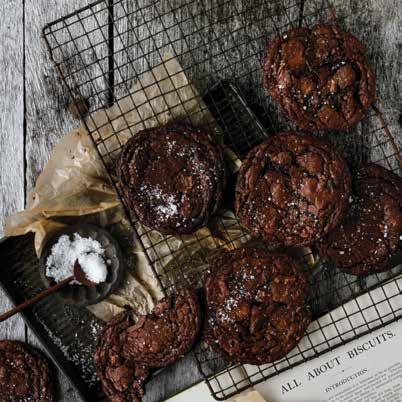
‘I FEEL LIKE SOMETHING ELSE’ TRIPLE CHOC BISCUITS
We have a thing in my household at those pre at-home movie nights or post sports event times when ineveitably one of us will say in a slightly puzzled tone, “I feel like something else.” At that point it is an open floor to pipe up with sweet little (or big) suggestions for a delicious treat, a sweet something to settle in with. These biscuits are those – rich, chewy and delicate with all, I mean all, the chocolate and a bit of roasted nut to be virtuous. The added sprinkle of sea salt perks up the chocolate flavours, so do not be scared, shower that sh*t on for added enhancment. They are a softer chewy biscuit, so keep them in an airtight container for a couple of days.
MAKES 15 OR SO LARGE BISCUITS
230g dark cooking chocolate
80g butter, softened
150g brown sugar
70g caster sugar
2 size 7 eggs
100g plain flour
50g cornflakes, finely ground
20g cocoa powder
1 tsp baking soda
250g chopped milk chocolate
50g toasted flaked almonds
sea salt flakes for sprinkling
Melt the dark chocolate then set aside to cool.
In a bowl or bowl of a stand mixer, cream butter and sugars until pale and smooth. Beat in the eggs one at a time. Add the melted chocolate and mix until combined.
Put the cornflakes in a food processor and blitz until a fine crumb forms. In a separate bowl, sift together the dry ingredients and stir through the ground cornflakes and almonds. Add to the stand mixer and slowly mix to combine. Once well combined, stir in the milk chocolate with a spoon.
Heat the oven to 180°C regular bake and line an oven tray with baking paper.
Spoon 6–8 heaped dessert spoon sized balls onto your tray, allowing room for them to spread. Sprinkle with flaked seasalt and bake for 8–10 minutes. Leave on the tray to cool and harden slightly before moving to a wire rack. Repeat with remaining dough. When cooled, transfer to an airtight container.
CHOCOLATE BASQUE CHEESECAKE
I made my usual vanilla Basque cheescake a few years ago and it was photographed as part of a festive editorial for a national magazine. I won’t name the publication, as the readers, I imagine, are much akin to the legendary readers of UK Horse & Hound, opinionated, unbudgingly fuddy, quite proper and easily offended (and it may bite me in the bum, just like their fussily groomed miniature Schnauzers). Anyway, my cake back then was perfectly dark, but alas, to those with no pining for pinxtos or much Spanish culinery nous at all, it looked burnt to buggery. And so it was shoved to the end of the spread, small and unfortunte, like some unavoidable, shameful, overcooked embarrassment.
Fast forward to now and the basic blackened Basque is found in many a Mediterranean-esque establishment across the motu. The deliberatly burnt-top combination of vanilla, cream cheese, eggs, cream, sugar and flour most probably these days pops into the chintz-lined mahogany dining rooms of my critics and I’m happy for them, I am. Gratefully I’ve since got over my woes and moved on, so here’s my swankier version for now, smacked full of chocolate for je ne sais quois, dark and mysterious, hopefully now she’ll get the page real estate she deserves.
Keep in the fridge for a few days (if it lasts that long) and always serve at room temperature with copious amounts of fluffy whipped cream dusted in cocoa powder.
NOTE – These days I try to eliminate as many of the inevitable variables with recipe sharing so weigh most of my solid ingredeints. With a digital set of scales on your bench you can whack out recipes tout suite without all that faffing about with measuring cups.
650g cream cheese
300g dark chocolate
1 tsp espresso powder dissolved in 1 tbsp hot water
4 large free range eggs
300ml fresh cream
280g caster sugar
1½ tbsp cocoa powder
1 tbsp plain flour
Grease and line a 25cm springform tin. Preheat oven to 180°C fan bake.
Place cream cheese in a stand mixer fitted with a paddle attchment and beat until smooth and creamy. While it’s beating, melt the chocolate (I zap mine in the microwve for 1 minute then let it sit for 2–3 minutes before strring together). Stir the dissolved espresso powder into the chocolate. Add this to the cream cheese and beat in until combined.
Add the eggs one at a time until incorporated.
Mix together the cream, sugar, cocoa and flour. Add this to the cream cheese mixture and beat until smooth.
Pour into pepared tin and bake for a little over an hour or until its wobbly in the middle and the top is dark and shiny.
Set aside to cool, then cover and chill.
Serve on a pretty plate dusted with cocoa and plenty of whipped cream on the side.
Add a few berries or bits of seasonal fruit, only if you’re feeling virtuous.
PAGE 50 | WWW.NOURISHMAGAZINE.CO.NZ
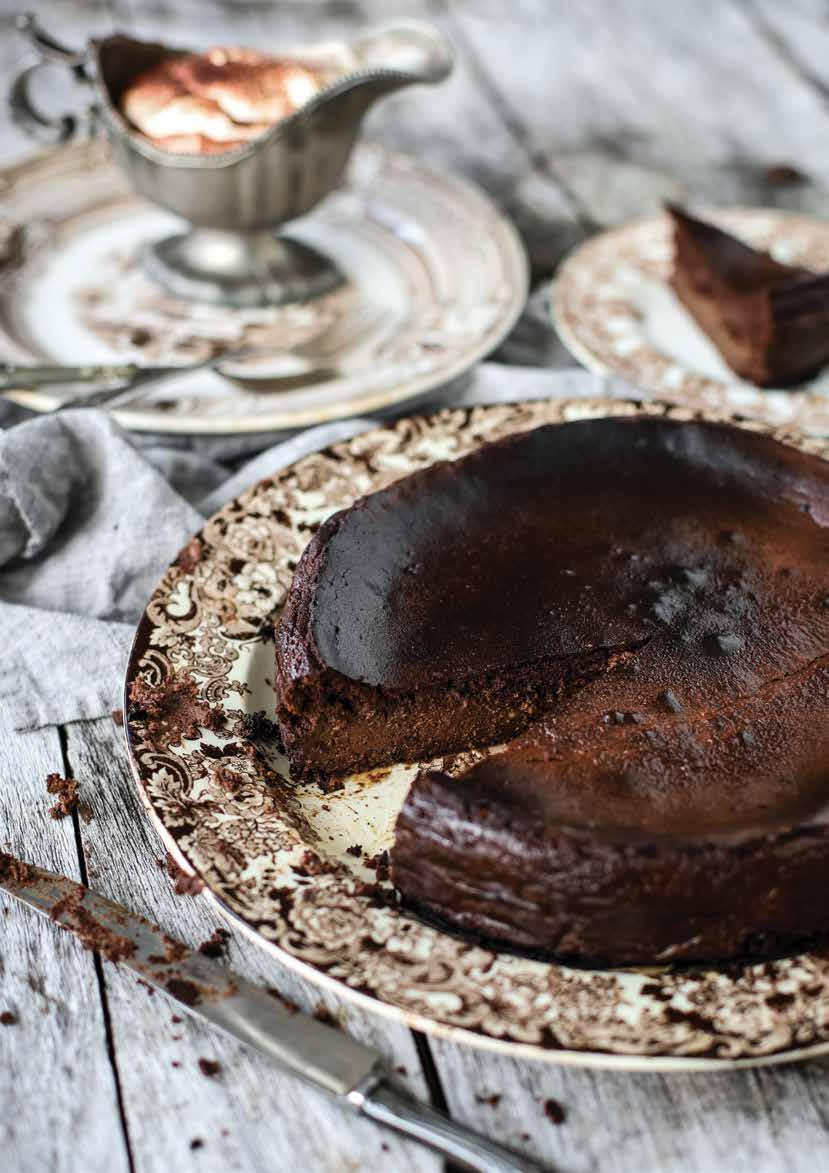
PAGE 51 | WWW.NOURISHMAGAZINE.CO.NZ


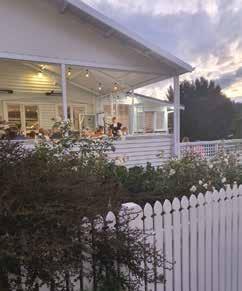
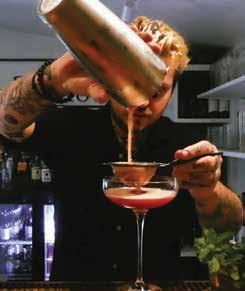

15E Minden Road, Te Puna | P. 07 552 4443 Tues - Sun 12 noon - 9.30pm | whitehousetepuna.com Your local destination FOR GREAT FOOD & COCKTAILS CORPORATE LUNCH & DINNERS AVAILABLE FIND OUT MORE AT www.thornegroup.co.nz Call (07) 575 5555 Architecturally designed and built by award-winning TG Homes, The Sands Terraces townhouses in Papamoa will change the way you think about coastal living. FOR SALE
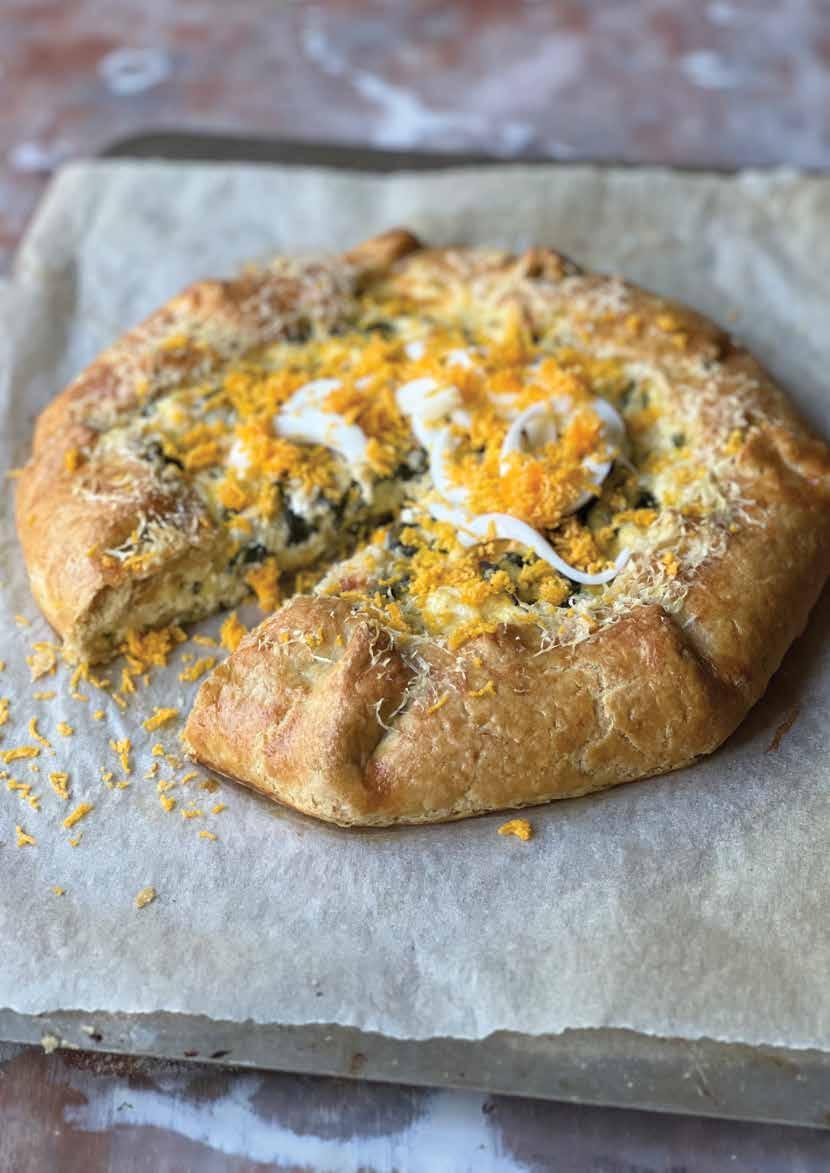
EASTER PIE
The brief to myself was to make a rustic pie that is a very loose play on the Italian Torta Pasqualina (an enclosed pastry pie using spinach and eggs). After many tests and neighbours’ approval, this one came out on top.
NOURISH | RECIPES
PAGE 53 | WWW.NOURISHMAGAZINE.CO.NZ
RECIPE & IMAGES KATHY PATERSON
EASTER PIE
SERVES 6
PASTRY
250g plain flour
150g cold butter, diced
25g cheddar cheese
5 tbsp cold water
1 egg, beaten for an egg wash or use a splash of milk
FILLING
120g packet tender spinach leaves, well washed
150g cow feta (or use goat’s milk cheese)
90g mozzarella (buffalo or cow)
125g ricotta
6 tbsp freshly grated parmesan or pecorino
1 egg, lightly beaten
TO FINISH
1 egg, hardboiled, optional
To make the filling, wilt the spinach in a saucepan with just the water that is clinging to its leaves then put into a sieve sitting over a bowl to drain. Set aside to cool.
Crumble the cow feta into a bowl. Grate the mozzarella, or, alternatively, tear into small pieces using your hands and add to the feta. Add the ricotta and 3 tablespoons of parmesan or pecorino. Add the egg and season with salt and pepper. Set aside.
To make the pastry, put the flour, a pinch of salt, and the butter in a food processor. Grate in the 25g cheddar cheese. Process until the mixture resembles fine breadcrumbs, then drizzle over the water and continue to process until the mixture just begins to form clumps. Tip out onto a lightly floured bench top and bring together, flattening to a disc shape.
Roll the pastry out into a 30cm disc then put onto a lightly greased baking tray (or line the baking tray with baking paper).
Squeeze any excess liquid from the cooled spinach and mix into the cheese mixture. Spread over the pastry, leaving a 5–6cm border around the edge uncovered.
Fold the uncovered edge of the pastry, pleating as you go to give a pastry edge to the pie. (There will be an open hole in the middle.)
Ensure the pastry does not split while folding, otherwise the filling may leak during cooking. Put in the fridge to firm up while you heat the oven to 200°C.
Remove from the fridge and brush the pastry top with enough egg wash or milk to coat and sprinkle the remaining parmesan or pecorino over the filling, sprinkling a little on the pastry as well.
Put in the oven and cook for 30 minutes until the pastry is beautifully golden brown and the filling just set.
To serve, cut the hardboiled egg in half lengthwise and scoop the yolk into a small, fine sieve. Cut the egg white into fine shreds and scatter over the pie. Push the egg yolk through the sieve directly over the pie.
TIPS – Swap out the spinach for the green leaves of silverbeet or use rainbow chard. You will need to wilt these a little longer until tender.
The delight of making the pastry in the food processor is that you can work with it straight away. In fact, you do not want it firm when you are folding it.
The pie can be eaten hot, warm, or cold.
HERBS AND GREEN LEAVES WITH MUSTARD DRESSING
Slightly bitter salad greens and herbs are gently pacified with a fullflavoured mustard dressing, so don’t be afraid to use them.
Shiso grows easily in the garden and taking over in mine is the variety that is green on one side, purple on the other. Shiso is from the mint family with flavour notes of basil, anise, and cinnamon.
SERVES 4
DRESSING
2 cloves garlic, crushed
1 tbsp Dijon mustard
1 tbsp sherry or red wine vinegar
4 tbsp extra virgin olive oil
SALAD
4 handfuls seasonal salad greens, torn if leaves are large
1 handful flat leaf parsley leaves
1 small bunch chives, snipped a few baby nasturtium leaves
3–4 shiso leaves, shredded to impart flavour
2 tbsp NZ Pinoli pine nuts, toasted
To make the dressing put the garlic, mustard, vinegar, and oil in a clean screw top jar. Season with salt and pepper then screw on the lid and shake well.
Gently toss the greens and herbs together then drizzle over enough dressing to moisten and gently toss again. Sprinkle over the toasted pine nuts.

Kathy Paterson
Kathy Paterson is a recipe developer, food stylist and photographer. A plentiful herb garden and a trial and error vegetable garden give Kathy the starting place for her recipes along with her love of the classics with a modern twist.
www.kathypaterson.co.nz
PAGE 54 | WWW.NOURISHMAGAZINE.CO.NZ





112 Third Ave, Tauranga | 0800 578 2832 | www.excelso.co.nz excelsocoffeenz excelso_coffee Always running out of coffee? Subscribe and we’ll make sure you never do. your coffee when you want it and we'll do the rest PAGE 55 | WWW.NOURISHMAGAZINE.CO.NZ

P umpkin to Talk About
RECIPES & IMAGES AMBER BREMNER
PAGE 56 | WWW.NOURISHMAGAZINE.CO.NZ
Move over pumpkin soup, time to try something new. Buttercup pumpkin (known as kabocha squash outside of New Zealand) is sweet and firm fleshed, with thin skin that’s good enough to eat when roasted. Here are two ideas – one simple, one requiring more effort – to enjoy buttercup pumpkin differently.
Buttercup with Rosemary, Orange + Chilli
A sizzling roasting dish of caramelised wedges of buttercup pumpkin, fragrant with rosemary, orange, and chilli is far more exciting than it has any right to be. The orange helps create sticky, crunchy edges and crispy skin, making for moreish bites that are delicious dipped into a creamy, tangy yoghurt and tahini sauce.
PUMPKIN
1 buttercup pumpkin
2 tbsp olive oil
2 cloves garlic, finely grated or crushed
1 tbsp fresh rosemary, finely chopped
1–2 red chillis, deseeded and finely chopped zest of one orange
2 tbsp freshly squeezed orange juice salt and pepper
YOGHURT TAHINI SAUCE
¼ cup yoghurt (dairy free or regular, I use coconut)
1 tbsp tahini (available from Vetro)
1 tbsp freshly squeezed orange juice pinch salt
Preheat oven to 220°C.
Wash pumpkin, cut in half and remove seeds, then slice into even sized wedges. Place wedges in a roasting dish or oven tray.
In a small dish, mix together olive oil, garlic, rosemary, chilli, orange zest and juice. Pour over pumpkin, then use your hands to rub the mixture over all surfaces. Season with salt and a good grind of black pepper.
Roast pumpkin for about 30 minutes (turn after 20 minutes), until the flesh is tender and the skin and edges are caramelised.
For the sauce, stir all ingredients together until smooth. Taste and adjust seasoning if necessary.
Serve pumpkin hot from the oven, with a dollop of yoghurt tahini sauce.

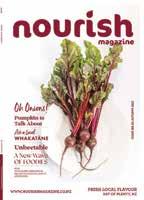


NOURISH | RECIPES The wild, up close and personal. Book at hamiltonzoo.co.nz See more, learn more, and get close in our Animal Encounters! $49 for a year of fresh local flavour delivered to your letterbox. Never miss a copy! SUBSCRIBE NOW AT www.nourishmagazine.co.nz/shop PAGE 57 | WWW.NOURISHMAGAZINE.CO.NZ
Stuffed Buttercup Pumpkin
Stuffed vegetables may not be at the cutting edge of modern cuisine, but I still love them for their homely vibes and let’s face it, they make a stunning centrepiece when you feel like making an effort. This buttercup is stuffed with a tasty mixture of wild rice, chunks of sourdough, apple, walnuts, and sage. The wild rice could be swapped out for half a cup of cooked lentils, brown or black rice, freekeh, or farro for a similar result.
¼ cup wild rice (or ½ cup cooked)
1 tbsp olive oil
1 onion, finely chopped
3 cloves garlic, finely chopped 6–8 fresh sage leaves
¼ cup walnuts
2 slices of sourdough (about 80g), ripped or cut into small chunks
½ a Granny Smith apple, cut into small dice juice of half a lemon salt and pepper
1 buttercup pumpkin

Start by cooking wild rice, by simmering in salted water for 20–30 minutes until tender with a little bite. Drain and set aside.
Preheat oven to 200°C.
Heat olive oil in a frying pan over medium heat. Add onion, garlic and sage and cook, stirring often, until tender and golden. Add walnuts and bread and cook for another few minutes, until lightly browned. Stir through the diced apple, squeeze over the juice of half a lemon and season well with salt and pepper. Turn off the heat.
Prepare pumpkin by washing the outside, then use a heavy knife to cut off the top

2cm in one piece (this becomes the lid). Use a spoon to scrape out the seeds and soft insides of the pumpkin (put these in the compost).
Pack the filling into the pumpkin, drizzle a little more olive oil over the filling, and rub some oil over the skin of the pumpkin. Put the lid on, then roast for 45–60 minutes, until the pumpkin is tender when poked with a toothpick. Take the pumpkin lid off at about 40 minutes, to allow the top to brown. Cut into wedges to serve.
Amber Bremner
Quite Good Food www.quitegoodfood.co.nz
Amber Bremner is the author of popular plant based food blog Quite Good Food. A champion for cooking and eating food that makes you feel good, she believes small changes in the way we approach food have the power to make a difference.
PAGE 58 | WWW.NOURISHMAGAZINE.CO.NZ
Nature Versus Nurture
This is an intriguing interplay. Nature plays a significant role in determining a woman's physical appearance. Genetics inherited from our parents largely shape our characteristics, such as facial features, body shape, skin type and hair texture. These genetics can be an absolute blessing and a challenge all at the same time. Talk to anyone with dead straight hair and they are likely to covet flowing curls and vice versa. Some women are blessed with high cheekbones, clear skin, little hair growth and an ideal body shape, while others may face challenges in these areas. It should be noted that few win the genetic lottery ticking all those boxes. Perhaps those high cheekbones you wish you had have been enhanced by clever makeup or that beautiful clear skin is the result of a clean diet and strict sunscreen regime.
It is crucial to recognise that beauty is not solely defined by genetic factors. Diversity in appearance is what makes the world an interesting place. And remember, beauty is subjective and encompasses a range of physical attributes. What one finds attractive i.e. freckles, another may not.
At Tranquillo we offer a full range of beauty therapy treatments, with a focus on advanced skin therapies, including IPL, dermal needling and Plamere.
These services aim to help women feel more confident and improve their self-esteem by enhancing their external appearance and natural beauty.
But nurture extends past the physical enhancements. Selfcare, confidence and a positive mindset are equally important. Emotional wellbeing has to be a factor in how we can feel and look ‘beautiful’.
Our role as beauticians is to help women strike a balance between their natural attributes and nurturing aspects of beauty. It’s our goal and pleasure to assist women in enhancing and celebrating their unique features, giving them some me time and helping them feel confident in their skin.
The interplay between nature and nurture is intricate. Nature provides the foundations while for nurture we offer services, treatments and products for enhancement.
At Tranquillo we can help you navigate this by offering a diverse range of services and products to cater for individual needs and preferences, giving you confidence and self-esteem to feel great and look great.

Sue

Beauty
Sue from Tranquillo Beauty in Tauranga has great advice each season to keep your skin beautiful and healthy. tranquillobeauty.co.nz PAGE 59 | WWW.NOURISHMAGAZINE.CO.NZ
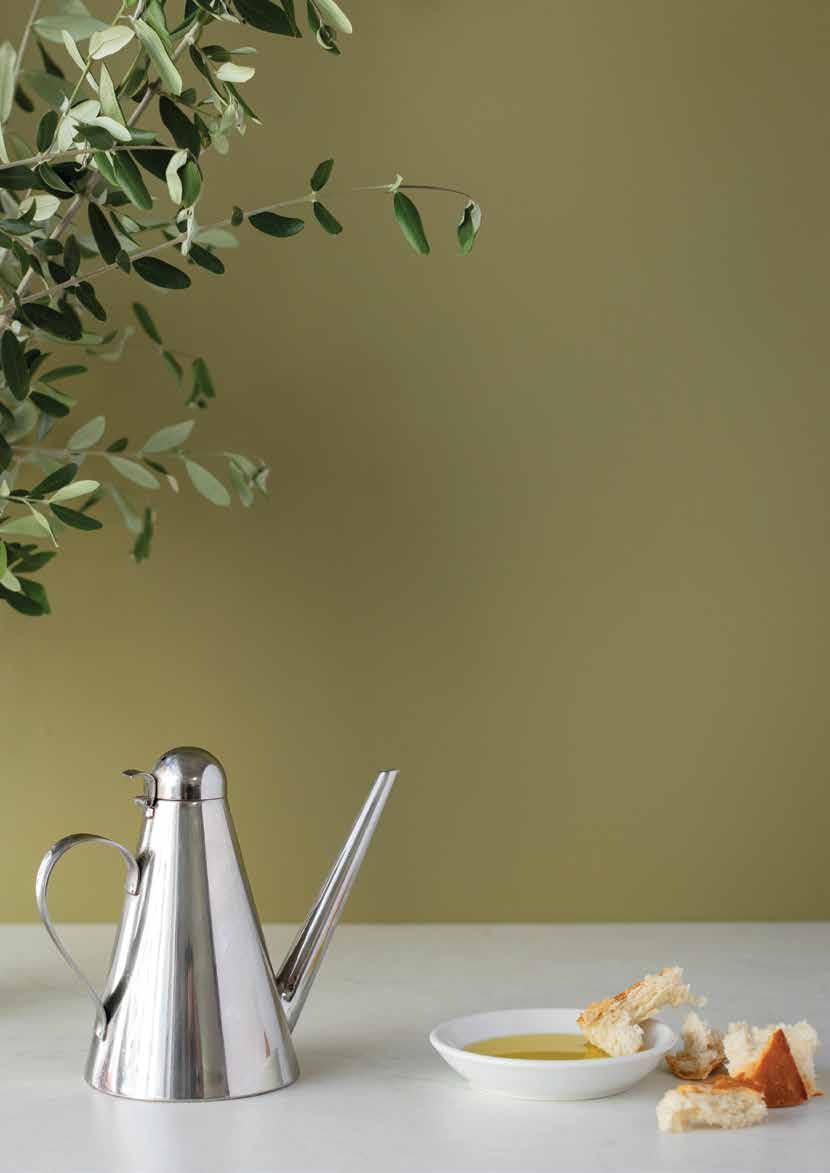
Liquid Gold
WORDS VICKI RAVLICH-HORAN | IMAGES ASHLEE DECAIRES
Liquid gold – this description for olive oil is becoming more and more accurate every year.
Prices of olive oil have skyrocketed in the last few years. Donald Montes from Taste of Greece has seen a 120% increase in prices in just one year. Increasing demand and falling production has predictably led to price increases, not to mention the rise of dubious practices when it comes to the labelling of this sought after culinary staple.
We consider olive oil a staple, but it’s a reasonably new food for New Zealanders. In her day my nana had to buy her olive oil from a chemist! And while it is commonplace now and can be found on every supermarket shelf, does this lack of tradition and understanding of the product mean we lack a real understanding of olive oil, its benefits, uses and what we’re really paying for?
To find out more we spoke to Liz from Vetro Tauranga, which sells a range of different olive oils from both the Mediterranean and New Zealand, along with Nathan Casey from Village Press in the Hawkes Bay, Gino Cuccurullo from Medifoods and Donald Montes from Taste of Greece.
Not all olive oils are equal. While country of origin and variety of olive is important to some, and we will come to that, it’s more important to understand the difference between an extra virgin olive oil and the plethora of other types of
olive oil.
EXTRA VIRGIN OLIVE OIL (EVOO)
This is the highest quality and purest form of olive oil. It is made from the first pressing of olives and most crucially is free from any chemical processing. EVOO has a low acidity level (usually below 0.8%) and a gorgeous flavour, ranging from peppery to grassy, fruity to nutty. It is commonly used for dressing salads, drizzling over cooked vegetables, and dipping bread.
VIRGIN OLIVE OIL
Rarely seen in New Zealand, this type of olive oil is also derived from the first pressing of olives but has a slightly higher acidity level (up to 2%). Virgin olive oil has a milder flavour compared to EVOO and is frequently used for cooking and sautéing.
OLIVE OIL
Sometimes referred to as ‘pure’ olive oil, this is a blend of virgin olive oil and refined olive oil. Refined olive oil has been processed using heat or chemicals. Olive oil has a neutral taste and a slightly higher smoke point compared to virgin olive oil, making it suitable for various cooking methods, such as frying and baking.
LIGHT OLIVE OIL
Despite its name, ‘light’ olive oil is not lower in calories or fat. It simply means that the oil has a lighter flavour and colour. Like pure olive oil, light olive oil is a blend of refined olive oil and EVOO or virgin olive oil and is good for recipes where a milder taste is desired or when cooking at higher temperatures.
PAGE 60 | WWW.NOURISHMAGAZINE.CO.NZ
OLIVE POMACE OIL
Sitting at the bottom of the hierarchy of olive oil grades, olive pomace oil is produced from the byproducts of the virgin and extra virgin olive oil production process. Around 5–8% of the oil remains in the olive pulp after pressing and extraction for extra virgin and virgin oils. To release this oil chemical solvents and heat are used in similar ways canola oil is extracted. The result is an oil useful for cooking but in no way has the benefits of an extra virgin olive oil. Donald says ‘pure’ and ‘light’ are not labels that exist for olive oil in Europe. This is because when they want to use an olive oil it is for its flavour as much as it is for the oil’s properties. Gino laments, “Imagine Caprese salad with canola oil. Life would never be the same.” I hasten to add the same gorgeous salad would be ruined by a drizzle of olive pomace or light olive oil too. Which brings us to the question – when is olive oil the right oil?
For me the benefits of an olive oil over others are the health benefits and the flavour. This means I am likely to only buy extra virgin olive oil and would use this in salad dressings, as a dip for bread, drizzled over grilled vegetables, a soup, pizza. I won’t use extra virgin olive oil in an aioli, as its flavour overpowers the mayonnaise, but I love it in the lemon cakes (on page 63), as it adds a lovely herbaceous note. I may use extra virgin olive oil when searing a steak, but I do so out of convenience as the heat will ruin the flavour of the oil. It’s convenient as I avoid oils that have had heat treatment or solvents used in their production which is also why you won’t find any other form of olive oil in my pantry other than extra virgin.
TASTE
As we’ve already established, other than extra virgin, all other olive oils on the New Zealand market have little flavour. For this reason, if taste is what you are after, extra virgin olive oil is your only choice.
The flavours of extra virgin olive oil will vary depending on a number of factors, including the type of olives used, the region they come from, the ripeness of the olives, and the production methods employed.
Liz from Vetro says, “We always sell a range of extra virgin olive oils so that people can find the flavour they like.” Liz is currently


loving the Iliada Greek oils. “I find them so smooth and flavourful. My favourite at the moment is the Early Harvest but that’s a special treat just for bread dipping and pouring over plain rice or pasta so the flavour is the star. I also use the Iliada gold tins for my dipping and pouring. I love extra virgin olive oil over my salads directly with a sprinkle of Maldon salt and an aged balsamic. No need to make it into a dressing. I just pour.” Liz also says, “I use one of our 3lt Il Podere or Mancini for my ‘everyday’ things like roasting veg, making a pesto, or a big slow cooked eggplant caponata style dish I make a lot in summer when eggplants are cheap. I always have a pot in the fridge. I love the stuff but it needs lots of olive oil."
QUALITY & AUTHENTICITY
When it comes to olive oil these two things are intertwined. With weather patterns changing in traditional olive regions resulting in falling production, countries like Tunisia are filling the gap. While Tunisia, like New Zealand, Australia and California, may be able to produce beautiful olive oils, it is unregulated and thus open to them producing quantity over quality.
The world of olive oil production in Europe is already rife with grim mafia practices and country of origin labelling often being fudged. This is why it is essential to buy from reputable companies and look for a seal or certification like a PDO.
Donald says, “I guarantee you not a single imported olive oil in a New Zealand supermarket is 100% extra virgin olive oil.” He can make this claim based on the sheer price so called extra virgin olive oil is sold at your local supermarket considering world demand and the cost to ship the oil to New Zealand.
New Zealand company Village Press have also been grappling with falling production and the cyclones in early 2023 played havoc with the harvest. For this reason Village Press added a small amount of oil from Europe to their traditionally 100% New Zealand oil. But to put this in context, Italy, the world’s second largest producer of olive oil now imports more olive oil from Spain than it produces. Liz says, “At the moment we are just trying to keep some good quality oils, from reputable suppliers, in stock and at a reasonable price.” So if you are looking for a delicious, healthy extra virgin olive oil head in to your local Vetro to discover the one that is right for you.

A Destination
Completely revamped - come and experience us!
Tara Rd, Papamoa p (07) 542-0190
112
www.pacificapapamoa.com
NOURISH | FEATURE PAGE 61 | WWW.NOURISHMAGAZINE.CO.NZ

OLIVE OIL RECIPES
WORDS VICKI RAVLICH-HORAN | IMAGES ASHLEE DECAIRES
PAGE 62 | WWW.NOURISHMAGAZINE.CO.NZ
OLIVE OIL AND LEMON CAKE
You can’t get more Mediterranean than olive oil and lemons! Like the Olive Oil Cookies, the oil in these cakes make them simple to make and means they keep fresh for a few days. I love the addition of thyme to the lemon syrup as it complements the herbaceous notes of the extra virgin olive oil.
1 cup extra virgin olive oil
1¾ cup sugar
3 eggs
3–5 lemons, depending on their size and juiciness
½ tsp baking soda
1 cup milk
1 tsp vanilla extract
2 cups flour
1 tsp baking powder
1 tsp salt
fresh thyme (optional)
Beat the olive oil and 1 cup of sugar together. I used a stand mixer but you could use a hand mixer or do this by hand to the same effect.
Add the eggs, 2 tbsp of lemon zest and ¼ cup of lemon juice and beat well.
Dissolve the baking soda in the milk and add to the batter along with the vanilla, flour, baking powder, and salt. Mix until combined.
Pour the batter into a greased 21–23cm cake tin or 8–10 Texas muffin pans or similar.
Bake at 180°C for 40–50 minutes for the large cake, less (around 30 minutes) for the smaller individual cakes.
While the cakes are cooking, make the lemon syrup by dissolving 1 cup of lemon juice and 1–2 tbsp of lemon zest with the remaining ¾ cup of sugar and fresh thyme if using. Bring to a simmer and reduce by half.
When the cake is slightly cooled, remove from the pan and drizzle over the lemon syrup.
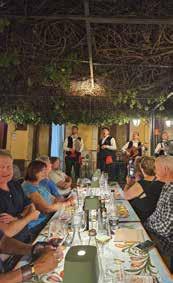

OLIVE OIL COOKIES
The olive oil in these cookies does two things: it shortens the time it takes to make a batch, as there is no creaming butter and sugar, and it results in a crispier texture without the cookies being hard.
Double this mixture, as the cookies last well. (Well, they do if hidden from the family.)
½ cup of extra virgin olive oil
½ cup brown sugar
½ cup sugar
1 egg
½ tsp baking soda
½ tsp salt
1 cup flour
¾ cup dark chocolate chips (I use Callebaut 42% Chocolate Callets from Vetro or 125g or half a block of 50% dark chocolate from Whittakers, roughly chopped)
Whisk together the oil and sugars. I used a hand mixer to do this. You could use a stand mixer with a whisk attachment or by hand. When the oil and sugars are well combined, whisk in the egg.
Now add the baking soda, salt, and flour and mix before adding in the chocolate. Place the cookie dough in the fridge for 30 minutes to firm up.
Roll dough into tablespoonfuls and place on lined baking trays. Bake at 180°C for 15–20 minutes, or until golden brown.


NOURISH | RECIPES Love Food? Love Travel? So do we! Join me on one of our small group Nourish Taste of Tours and enjoy both plus a whole lot more. Coming in 2025 – Sicily, South Australia and Sri Lanka BE THE FIRST TO KNOW! SIGN UP AT nourishmagazine.co.nz/nourish-foodie-tours SICILY 2024 – ONLY 4 SPACES LEFT. PAGE 63 | WWW.NOURISHMAGAZINE.CO.NZ

AGLIO OLIO
With a jar of confit garlic in the fridge you can have a tasty bowl of pasta ready in the time it takes you to cook the pasta. Simply cook your spaghetti pasta in a large pot of boiling water. When it is nearly cooked, for every serving, heat a generous spoonful of the confit garlic oil in a pan, making sure you get a few of the garlic cloves. Smash the garlic up and add a dash of dried chilli flakes (optional).
Add the cooked pasta with a little of the cooking water and a generous amount of grated parmesan. Stir to combine and serve.
CONFIT GARLIC
Confit simply means cooking in oil. Slowly cooking garlic in olive oil gives you beautiful soft garlic with a more subtle flavour than raw to use in cooking, spread on sandwiches, add to aioli and dressings and more. With New Zealand garlic back in season, this is the perfect time to confit garlic and reap the benefits of always having a flavourful oil and preserved confit garlic on hand.
To make, simply peel your garlic cloves and cover with extra virgin olive oil. If you like, you can add some thyme or rosemary. Cook in the oven at around 120°C for an hour to an hour and a half or until the garlic is super soft.
Allow to cool completely before placing in a jar and storing in the fridge.
PAGE 64 | WWW.NOURISHMAGAZINE.CO.NZ

4-14 APRIL 2024 TICKETS ON SALE NOW! Join us for a culinary collision across the Coastal Bay of Plenty! flavoursofplentyfestival.com
EVENTS


TAURANGA FARMER'S MARKET
Where local and convenience collide. The Tauranga Farmer's Market is on every weekend, rain, hail or shine.
Saturday 8am–12noon
31 Fifth Ave, Tauranga www.tgafarmersmarket.org.nz
BALLOONS OVER WAIKATO
Balloons Over Waikato celebrates the milestone of 25 years as the balloons float back into the city from 19 March.
Festivities kick off in Hamilton Central with the Love the City Walk Thru on Saturday 16 March from 1pm to 4pm.
Tuesday 19 – Saturday 23 March
Start your day the best way possible, grab the family and join us from 7am to watch the balloons lift off from Innes Common and float away.
Saturday 23 March
Zuru Nightglow at Claudelands Oval. www.balloonsoverwaikato.co.nz



FALLS RETREAT WORKSHOPS
‘Full Monty’ Edible Gardening Workshop –
Sunday 7 April & Friday 3 May
Sourdough Bread Making – Friday 12 April Pickling & Preserving Masterclass – Friday
$150pp includes morning tea and nibbles on arrival, workshop booklet to take home and delicious shared lunch. www.fallsretreat.co.nz
FALLS RETREAT EASTER FEAST
Gather your family and friends for this special event! This is a leisurely lunch with everyone seated on long tables. Our chefs will create a special three-course set menu using homegrown produce from our organic veggie gardens and local farmers, plus a housemade welcome drink and breads on arrival with the opportunity to wander around our kitchen gardens, utilise our outdoor games and explore the kids playground.
Sunday 31 March, 11.30am
$85pp ($35 for kids, 2 courses) www.fallsretreat.co.nz
PORT OF TAURANGA NATIONAL JAZZ FESTIVAL
The long-standing and widely beloved Port of Tauranga National Jazz Festival turns 61 this Easter and is celebrating with a dazzling programme of events which bring the swing to Tauranga Moana.
23 March to 1 April www.jazz.org.nz






DECADES CHARTED: A WINDOW INTO THE CHARTWELL COLLECTION
A bold exhibition of Aotearoa New Zealand contemporary art, in celebration of the 50th anniversary of the Chartwell Collection. Open from 23 February | Free entry
Waikato Museum Te Whare Taonga o Waikato
TE PANI, TE POUARU, TE RAWAKORE: NURTURING GENERATIONS THROUGH POUKAI
Filled with colour photographs, this exhibition showcases the ongoing tradition of Poukai (marae gatherings), first introduced in 1885 by Kiingi Taawhiao.
Open from 1 March | Free entry
Waikato Museum Te Whare Taonga o Waikato
SOUTH EAST ASIAN WITH WAYNE GOOD
Focusing on Thai, Vietnamese and Balinese dishes, all wonderfully fresh flavours and very light to eat. Day includes refreshments, lunch and cooking demo.
Saturday 13 April or Sunday 14 April, 9.30am |
Cost: $90.00 pp
128A Whitikahu Road, Gordonton.
To book email please at wayne@arkanda. co.nz, or phone 021898909.
When booking, please include your phone number.
FLAVOURS OF PLENTY FESTIVAL
Celebrate Coastal Bay of Plenty’s worldclass food scene, showcasing the region’s horticultural heroes and weaving a powerful connection from our place to your plates in the third annual Flavours of Plenty Festival. 4–14 April
www.flavoursofplentyfestival.com
NOURISH & FALLS RETREAT
Join Vicki from Nourish for a fun cooking demonstration, followed by a gorgeous lunch prepared by the Falls Retreat team. Price includes a copy of Nourish, The Cookbook, vol 2. Sunday 26 May, 10.30am
Cost $149pp
www.fallsretreat.co.nz
NOURISH TASTE OF SICILY TOUR
Join Vicki for an amazing 10 days discovering the real taste of Sicily. In this small group tour we will make pasta in an old monastery, sip wine as the sun sets over ancient vineyards, zip around the streets of Modica in fiat 500s, marvel at beautiful architecture while enjoying some famous granita in Noto, and see traditional cheese being made, plus a whole lot more.
20–30 October
$7995pp (twin share)
BOOK NOW – just 4 spaces left!
www.nourishmagazine.co.nz
PAGE 66 | WWW.NOURISHMAGAZINE.CO.NZ





























MARKETPLACE COOK. BAKE. Create. CHECK OUT OUR HOMEWARE RANGE ONLINE AND INSTORE. @READ BROS. 308 Pollen St, Shortland, Thames www.readbros.co.nz SHOP DIRECTORY 12 CHURCHILL ROAD, TAURANGA | 07 579 9781 EPICUREAN EXPERIENCE tgatastingtours Email STYLE Vintage & Antique Homewares and Jewellery French Brocante and english country Wares NeW and recycled clothiNg 40 duke street, cambridge shop@theheritagetradiNgcompany.com image: agNes grace PhotograPhy OPEN THURS - SUN 10AM TO 4PM 128 Whitikahu Rd, Gordonton, Hamilton | www.arkanda.co.nz A FANTASTIC ARRAY OF ANTIQUES Furniture • Decorative French • Vintage Rural Barn Setting LOVE NOURISH? So do our awesome clients. Get in touch to see how we can help your local business. vicki@nourishmagazine.co.nz 0210651537














Discover a world of flooring inspiration, leading brands and expert advice.
Timber Flooring: Godfrey Hirst Oak Elegance in colour Coastal Oak








 Vicki Ravlich-Horan Editor
Vicki Ravlich-Horan Editor













































 Rachel Hart
Rachel Hart



















































































































